Wine, History, Culture:
12 Days: Sunday, June 09 - Thursday, June 20, 2024
Accommodation: 11 nights:
Night 1: Sunday, June 09Oceania l’Hôtel de France in Nantes, a 4-star true Nantes institution in an 18th century mansion ideally situated in the city center and a stone throw from the majestic Passage Pommeraye. The hotel has recently been completely renovated and very tastefully combines old world charm with a contemporary off-beat twist. |
Nights 2 + 3: Monday, June 10 + Tuesday, June 11Hôtel d’Anjou in Angers, a charming, recently updated 4-star hotel in the heart of the city of Angers welcoming sophisticated guests since 1857. New additions to the hotel are the restaurant in an exceptional space decorated with mosaics dating from the 1930s and the great spa area with sauna, hammam, and Nordic bath. |
Nights 4 + 5: Wednesday, June 12 + Thursday June 13Hôtel Mercure Bord de Loire in Saumur, a modern 4-star hotel located on an island in the Loire River with a panorama terrace overlooking the Château de Saumur, the old town, and the historic monuments. |
Nights 6 + 7: Friday, June 14 + Saturday, June 15Hôtel Mercure Centre in Blois, a 4-star modern hotel on the banks of the Loire River within a five minute walk to the city center of Blois and the Royal Château of Blois. We are also close to some of the most beautiful and important Loire Châteaux such as Chambord. The hotel has a very nice indoor pool, sauna, and a hammam. |
Night 8: Sunday, June 16Hôtel Château de Prey, a 4-star romantic hideaway in the heart of the Loire Valley. The origins of this magnificent Loire Château dates from the 12th century. It is situated a couple of miles from the town of Amboise and is tucked away in a vast park with a very nice outdoor pool and a huge terrace to relax. |
Night 9: Monday, June 17Auberge du Bon Laboureur, a 5-star very charming, luxury hotel in the heart of the little town of Chenonceau, steps away from Château Chenonceau. The building dates from 1786 and was once the town's post house. There is a beautiful garden with a very nice pool and an excellent restaurant. |
Nights 10 + 11: Tuesday, June 18 + Wednesday, June 19Le Panoramic Hôtel in Sancerre, a wonderful, recently completely renovated 4-star hotel with breathtaking views over the Sancerre vineyards and a stone’s throw from charming old town Sancerre. |
DAY 1: Sunday, June 09 |
MORNING / EARLY AFTERNOONArrival in Nantes, check-in at Oceania l’Hôtel de France.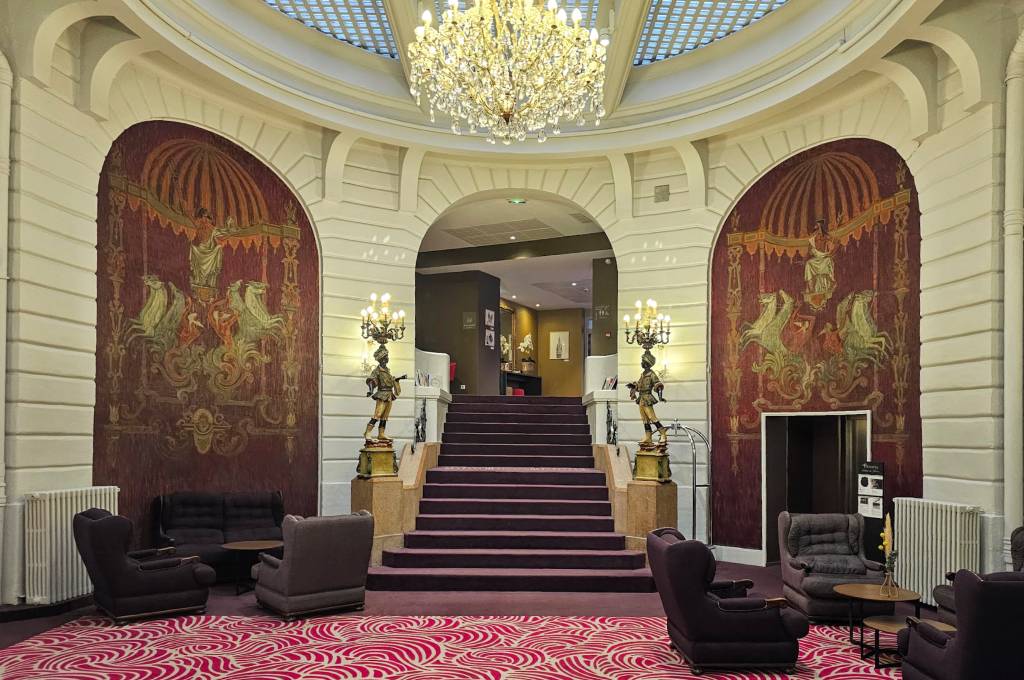
Welcome coffee and meet & greet in the Oceana Hôtel in Nantes. |
AFTERNOONGuided tour of the historic city of Nantes.
|
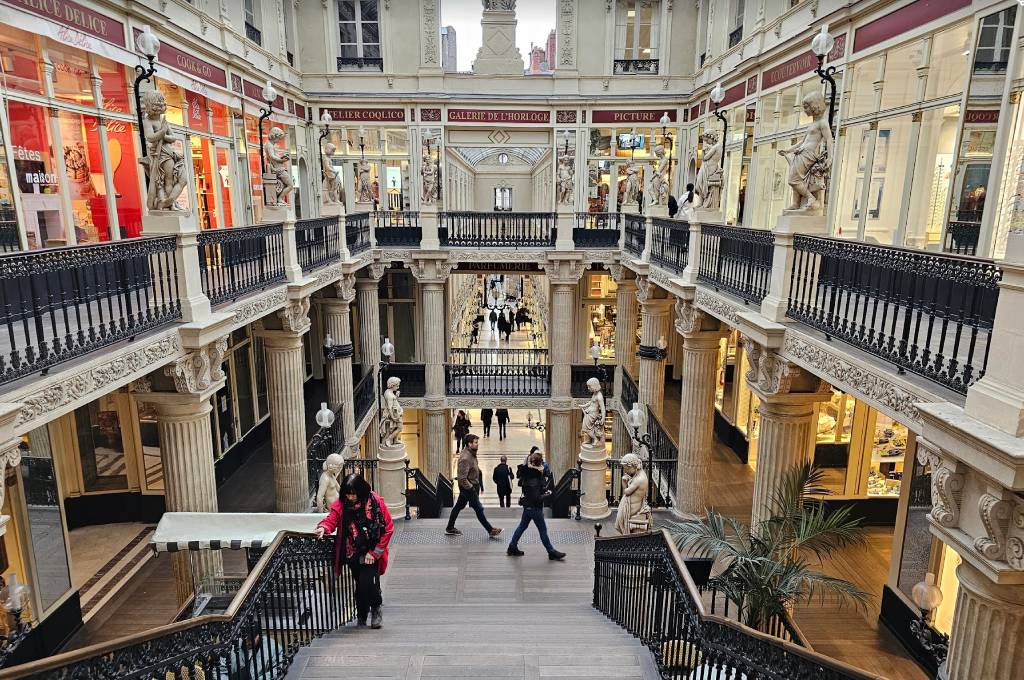 Time to visit the Passage Pommeraye, a spectacular 19th-century glass-roofed shopping mall, and the Cathedral of St. Peter and St. Paul of Nantes as well as old town Nantes with its half-timbered houses. Time to visit the Passage Pommeraye, a spectacular 19th-century glass-roofed shopping mall, and the Cathedral of St. Peter and St. Paul of Nantes as well as old town Nantes with its half-timbered houses. |
EVENINGDINNER at restaurant "La Cigale" in Nantes.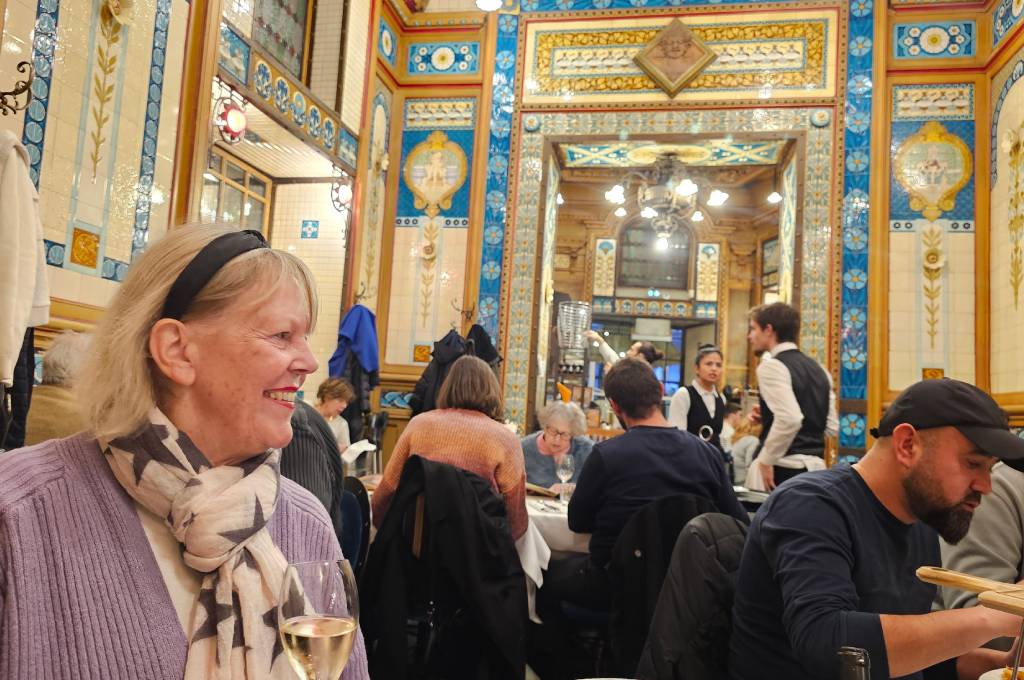
This brasserie across from the opera house of Nantes, established in 1895, displaces all the images of the classic, voluptuous style of the late 19th century: an intoxication of ornamental decoration and on top of it a superb meal. |
DAY 2: Monday, June 10 |
Exploring the Loire Valley wines
We start off exploring the Loire Valley wines in the Atlantic region of the Pays Nantais or Lower Loire, the easternmost and last Loire Valley wine region before the Loire River empties into the Atlantic Ocean. The Muscadet Sèvre et Maine wine-growing region is located on a southern slope, at the confluence of the rivers Sèvre and Maine. The soils are mainly different types of schist. This region is almost exclusively devoted to white wine, the “Muscadet” - made from the “Melon de Bourgogne” grape - with crackling acidity and sleek citrus fruit. These are sea-side wines with an emphasis on freshness and the perfect pairing with all sorts of seafood. I quote Flatiron Wines: “Oysters and Melon de Bourgogne: a magical pairing, the two together really are more than the sum of two.” |
MORNINGVisit of Vignobles Günther Chéreau, Château du Coing in Saint Fiacre-sur-Maine, Pays Nantais.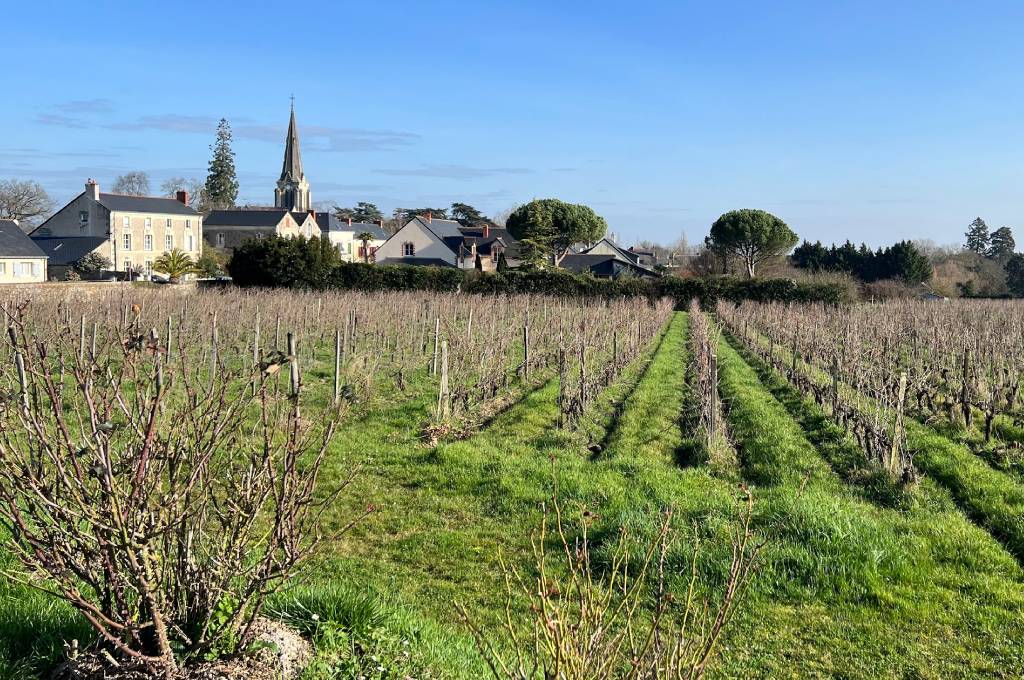
There is evidence that the lands in this region have been cultivated since Roman times. One can see cellars, hewn from the ground and built up with schist and sandstone. The origins of the Château du Coing go back to the 15 th century. In 1973 the domaine was acquired by Bernard Chéreau and his wife Edmonde Carré. In 1990 their daughter Véronique Günther-Chéreau, a trained pharmacist, took over. Today her daughter Aurore takes on more and more responsibilities. They cultivate 110 acres of vineyards, almost all are planted with the Melon-de-Bourgogne grape and with a small percentage of Chardonnay. 60 acres are planted with vines that are over 80 years old. Winemaking is according to “Lutte Raisonée”. The yields are kept down to 50 hl/ha and spontaneous fermentation is the rule. I quote Chris Kissack, The Winedoctor: “All the same, these are wines of considerable polish, depth and substance at the upper level. I’m impressed.” |
LUNCHVisit of Vignobles Günther Chéreau, Château du Coing in Saint Fiacre-sur-Maine, Pays Nantais.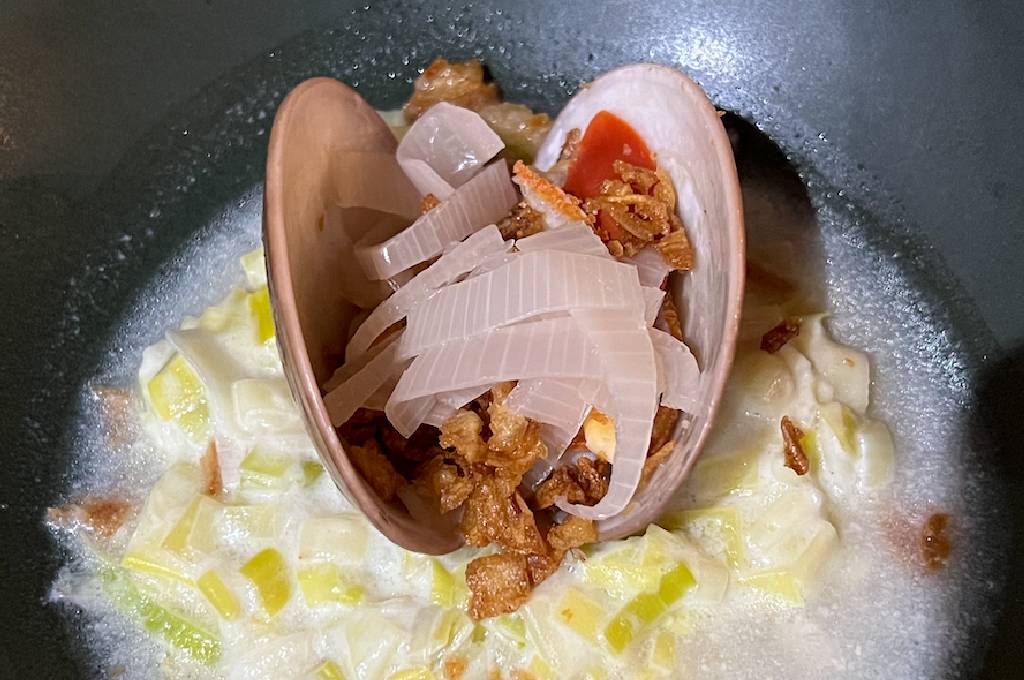
This We will have a delicious lunch with matching wines at Château du Going. Véronique Günther Chéreau and her daughter Aurore will join us and pour wines which will match the dishes served. |
AFTERNOONVisit of Domaine Gadais Père et Fils in Saint Fiacre-sur-Maine, Pays Nantais.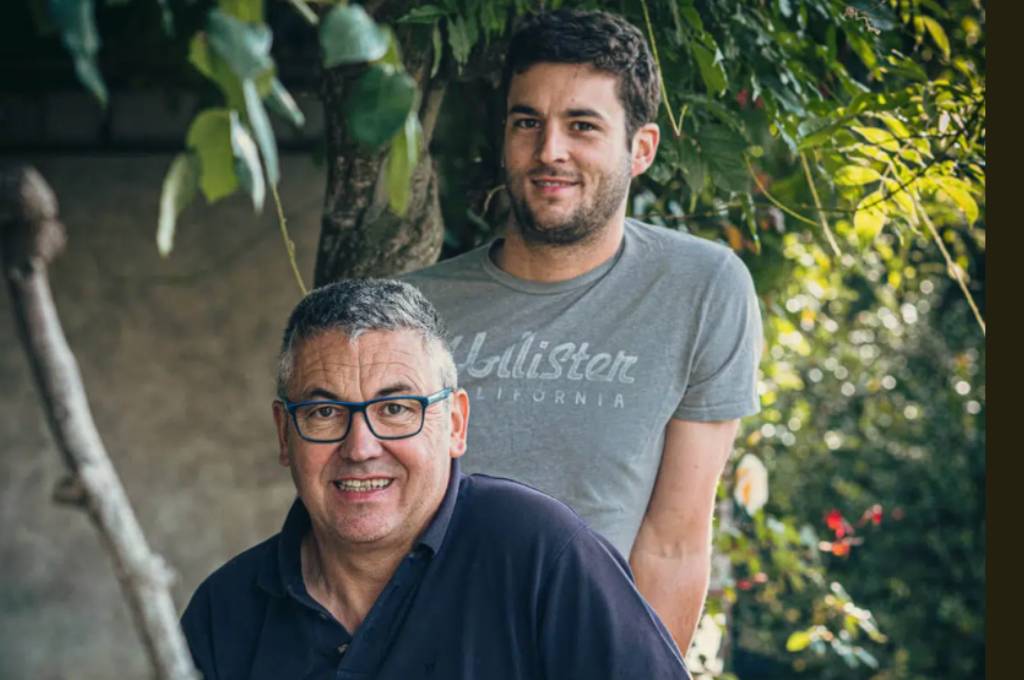
The domaine exists as a mixed farming estate since before the French Revolution. In 1947 Louis Gadais decided to concentrate only on wine production. In 1958 they wrote history when Franck Schoonmaker, an importer of high-quality French wines paid them a visit and started to import Gadais Muscadet wines into the US. Today it is Christoph Gadais, fifth generation, and his son Pierre-Henri Gadais, great-grandson of two brilliant Loire winemakers – Louis Gadais in the Muscadet region and Henri Bourgeois in the Sancerre region (whom we will visit on the last day of this wine tour) who are running the domaine. Pierre-Henri pushes the domaine into a new direction: while training abroad he gained interest in organic and biodynamic agriculture and they farm sustainably now. The 125 acres of vineyards are exclusively planted with the Melon de Bourgogne grape and are divided into 100 small parcels to show the specific terroir. “It is the richness and geological diversity, as well as limited yields, that have earned the estate its reputation today” the Gadais family. |
EVENINGArrival and check-in at Hôtel d'Anjou in Angers.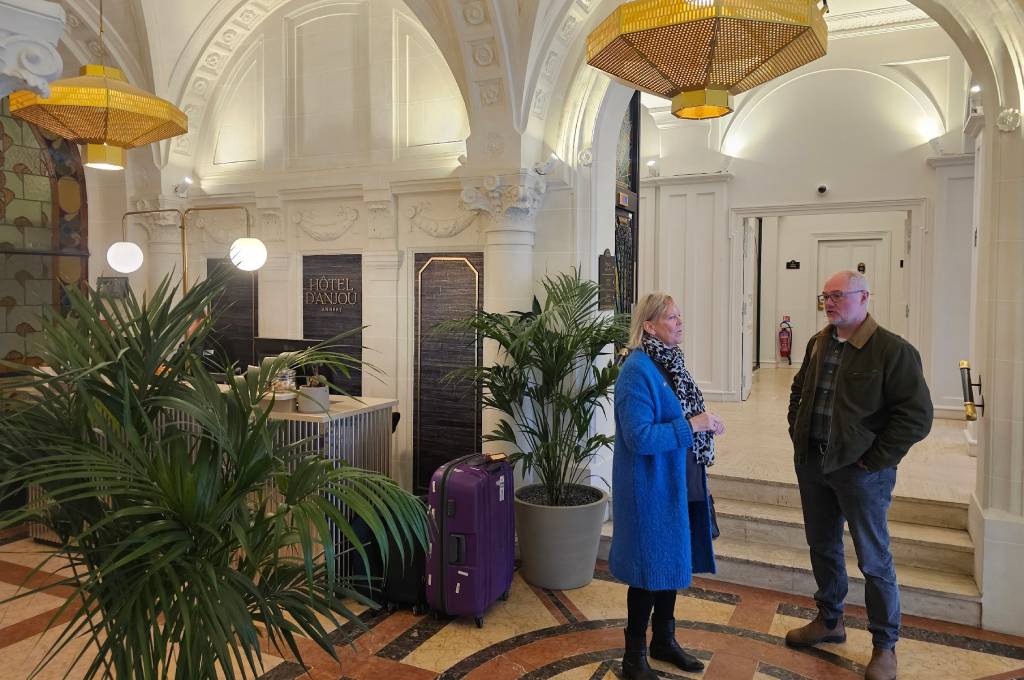
Time to relax before we take a short walk to dinner. |
DINNER at Restaurant Les Petits Près in Angers.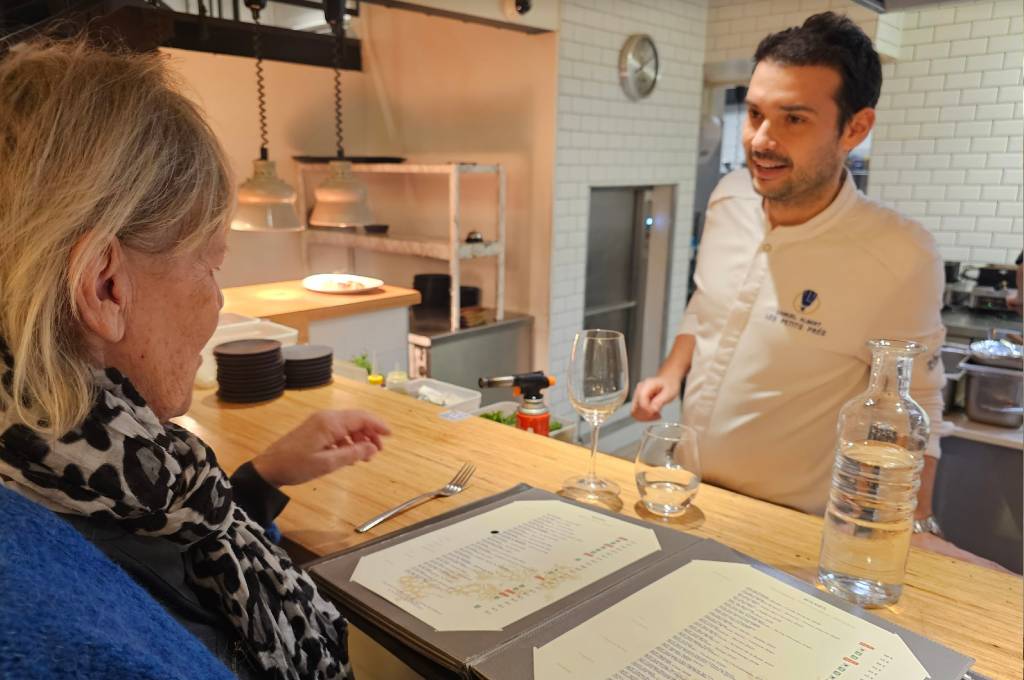
This is the restaurant of Samuel Albert, who won the 10th series of the French version of the show Top Chef. The menu is created with local incredients and is the expression of Samuel Albert’s travels: a fusion between Europe, Asia, and America. |
DAY 3: Tuesday, June 11 |
|
The next days we scout out the Anjou-Saumur wine region. The maritime influence fades and one can sense the shift towards a continental climate. Anjou and Saumur’s most famous grapes are Sauvignon Blanc, Chenin Blanc, Cabernet-Franc. However, we will also taste fantastic wines made from a range of other grapes mostly unfamiliar to us until now. Two subregions meet and here are the most prominent wines of the regions: Anjou: dry white wines: Sauvignon Blanc and Chenin Blanc, where Savennière is the top region for Chenin Blanc; noble sweet Chenin Blanc along the Layon river, a tributary of the Loire; red wines: Cabernet Franc, Gamay and blends; the well-known Rosé d’Anjou, mostly a blend of Cabernet Franc and Grolleau. Saumur: red wines from Cabernet Franc, where Champigny is the most prominent region; and for the bubbles afficionados: Crémant de Loire |
|
This morning we explore the AOP Savennières appellation. The fact that great Chenin Blanc, bursting with power, depth, elegance, and freshness, are produced in the Loire Valley, in particular in Savennières, is not on everyone’s radar. These wines compete with the great Chardonnays of Burgundy. The reputation comes from some seriously strict regulations in the AOP Savennières concerning vinification: Chenin Blanc is the only grape allowed in the region, harvesting must be by hand, and mandatory low yields guaranty optimal flavor and ripeness in each grape. |
MORNINGVisit at Château d'Épiré, Savennières, Anjou.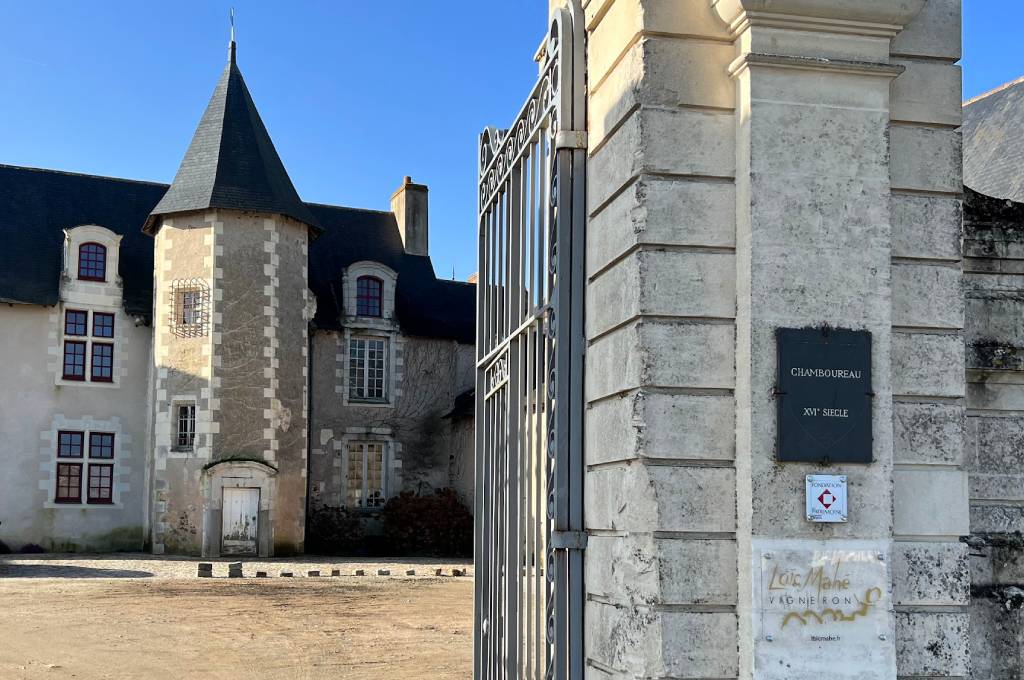
Château d’Épiré is one of the oldest and most prominent wine estates in the Loire Valley. It was founded in the 17th century and has never been sold. Originally the castle and wine estate belonged to the Pons de Las Cases family. (For the history buffs among us: after Napoleon was shipped to the island of St. Helena, he dictated his memoires to Emmanuel Pons de las Cases.) The widow of Emmanuel Pons de las Cases was childless and had no heirs. When she died in 1882 she bequeathed the castle and wine estate to her closest friend Théophile Bizard. He settled down in Épiré and continued with the wine production tradition. Today the fifth generation, Paul Bizard manages the estate. They farm 25 acres in the best part of the Savennière appellation, planted with Chenin Blanc. The small village of Savennières is perched on a rocky plateau 40 meters above the Loire river. The vineyards slope down in a perfect south-southwest exposure. The estates winemaking and storage facilities are in a unique location: a half buried underground roman-catholic church, built in the 12th century by Cistercian monks, serves as perfect facility. The one meter thick walls keep the temperature stable inside and year around. Château d’Épiré produces 3 top dry cuvées, which are all quite different. The mainstream “Château d’Épiré” is fermented and matured in stainless steel. The “Cuvée Spéciale” comes from a ½ acre parcel of unusual black stones terroir and is fermented and matures in old barriques. The “Hu-Boyau” comes from the oldest plot and is fermented and matured for 9 months in 18 year old oak barrels undergoing malolactic fermentation. |
Visit of Château des Vaults, Domaine du Closel in Savennières.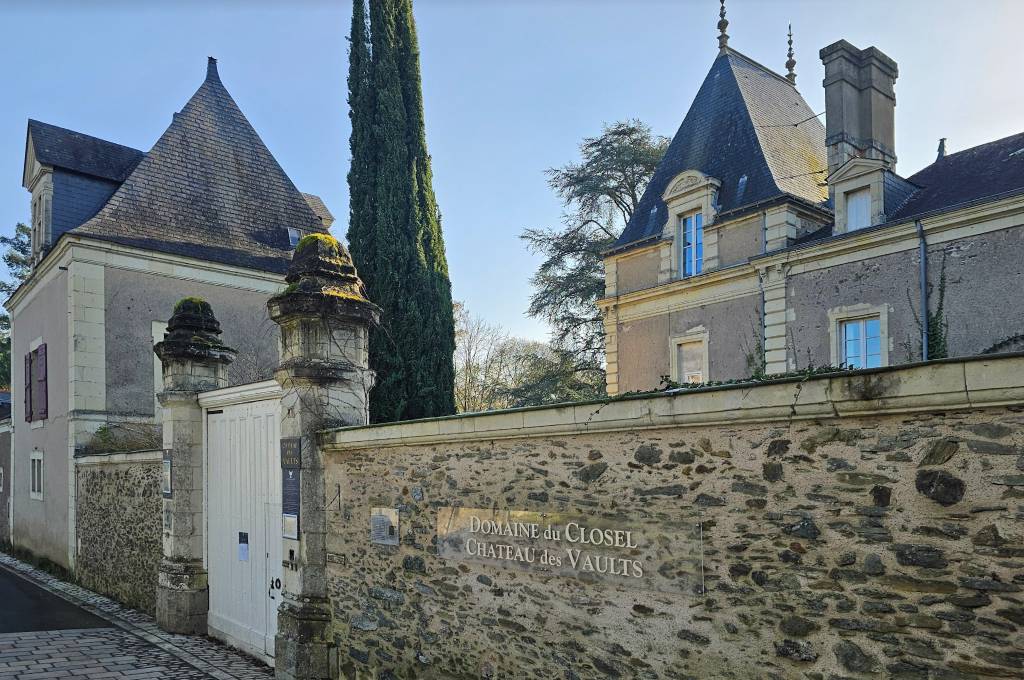
Domaine du Closel is located in the appellation of Savennières and produces some of the most beautiful Chenin Blanc wines. The property, the impressive Château des Vaults, was first mentioned in 1495. The château we see today was rebuilt in the 19th century and the park was created in 1850. At that time the family of Emmanuel de Las Cases, biographe of Napoleon, inherited the château and a line of female winemakers and estate managers was born. In 2001 Evelyne de Pontbriand, a literary scholar, who had lived and worked in the US and Germany, took over the reins. The 35 acres of vineyards are spread out on the most western hill of Savennières and the best plots are Les Caillardières and Clos du Papillon. Evelyne de Pontbriand, who will show us her estate, is a lover of botanics and nature. She immediately started the conversion to organic and biodynamic viticulture and today the domain is certified organic and biodynamic by Ecocert and Demeter. Evelyn’s goal is to make wines that are expressing their origins. She says: “Thanks to grassing and plowing, the life of the soil is respected, the soil’s micro-organisms are active: oxygen comes into action allowing maximum exchanges between soil and vine. This is how we obtain the famous terrior effect: combination of soil, the precocity of its warming, plant material, and light.” Madame Evelyne de Pontbriand will be our host. |
LUNCHWine Pairing Lunch at Château des Vaults.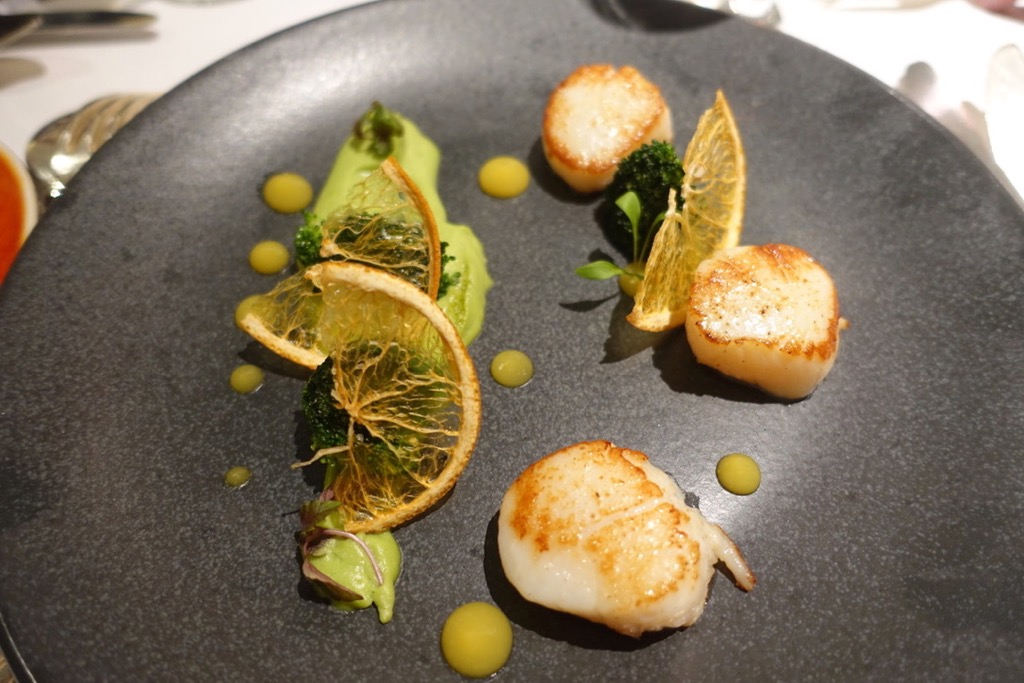
Chef Arthur Favé of the Michelin-starred restaurant Le Chenin, which sits right in the center of the very picturesque village of Savennière will prepare a delicious meal which Mme de Pontbriand will match with her wines. |
AFTERNOONGuided visit of the Château d'Angers and La Tapisserie de l'Apocalypse listed as UNESCO World Heritage Monument.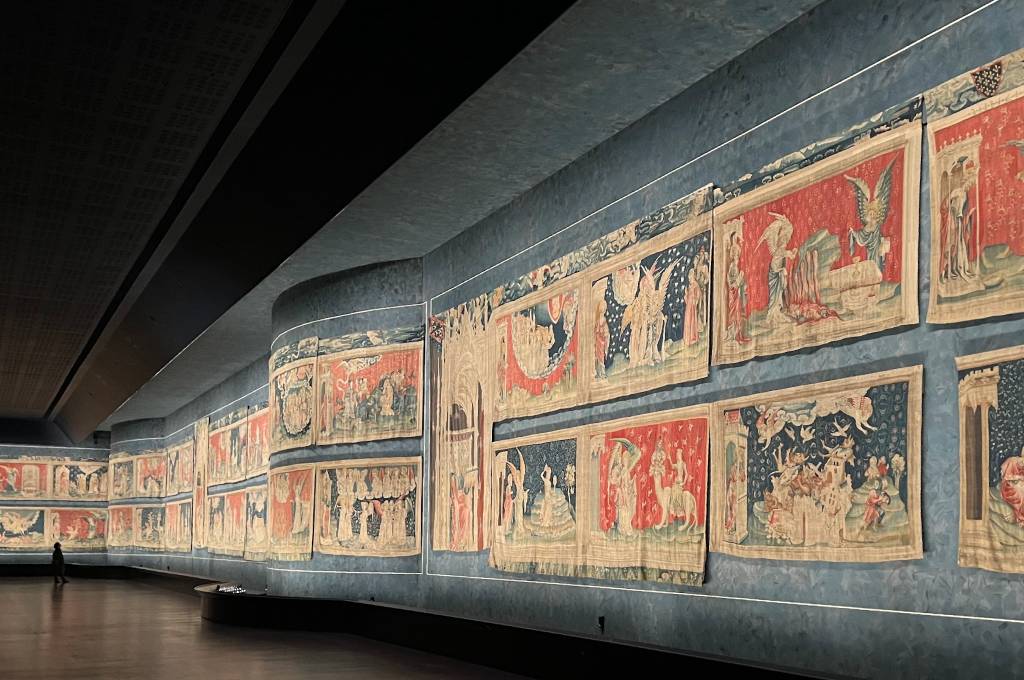
Construction of this mighty fortress and castle started in 970 to protect the Anjou region from any invasion coming from the north from Normandie. You will feel tiny when you stand before this imposing Medieval fortress with its 17 defensive towers. The main attraction of this castle however is the exhibit of the Apocalypse Tapestry. This incredible monumental medieval work – designed to be transported from place to place – is the largest set of tapestry known to date. It was commissioned by Louis I, the Duke of Anjou in 1373 and it took seven years to finish. The tapestry describes the story of the Apocalypse from the Book of Revelation in colorful scenes in 74 pictures: 103 meters long, 4.50 meters high, 74 scenes, virtuoso weaving, striking details, expressive characters, a fantastic story evoking wars, pollution, disease, famine, death, but also hope: an encounter with a masterpiece unique in the world. |
EVENINGDINNER at restaurant Odorico.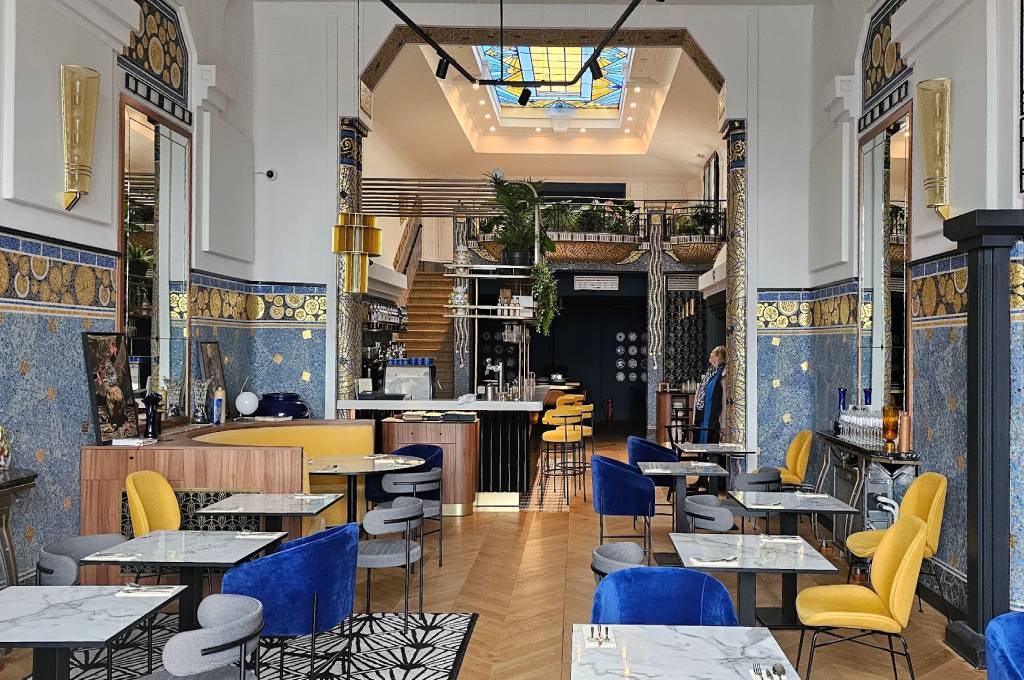
This restaurant is adjacent to the hotel d'Anjou. |
DAY 4: Wednesday, June 12 |
MORNINGVisit of Domäne Vincendeau in Rochefort-sur-Loire, Anjou.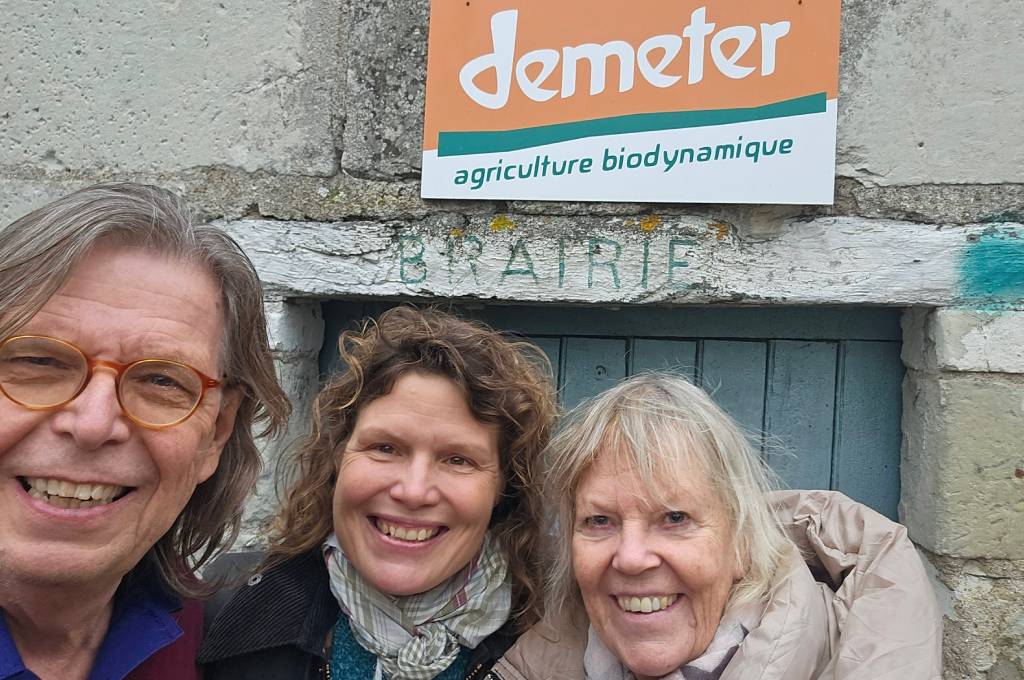
I let Liv Vincendeau speak: “Born in Darmstadt, Germany, where I also grew up, I first went to study (Master II in chemistry) in York (UK) and Strassburg (Alsace). Arriving in Anjou in 2000 during viticulture-oenology training, I have remained faithful to this beautiful province ever since. Creating my own domain – a dream!... and then a carefully prepared project. Many winegrowers from France and elsewhere have passed on to me their know-how and their passion for this magnificent profession. I thank them wholeheartedly. 2014 is the year of implementation and since then each vintage is a new adventure.” She produces racy Chenin Blanc, two types of Rosé produced from a blend of traditional and autochthon grape varietals, a noble sweet Coteaux du Layon Rochefort, and spectacular Crémant de Loire. Her Crémant “Zeitlos” is raved about in every single top wine magazine. The domaine is certified biodynamic by Demeter. |
Visit of Domaine de la Soucherie in Beaulieu-sur-Layon, Anjou.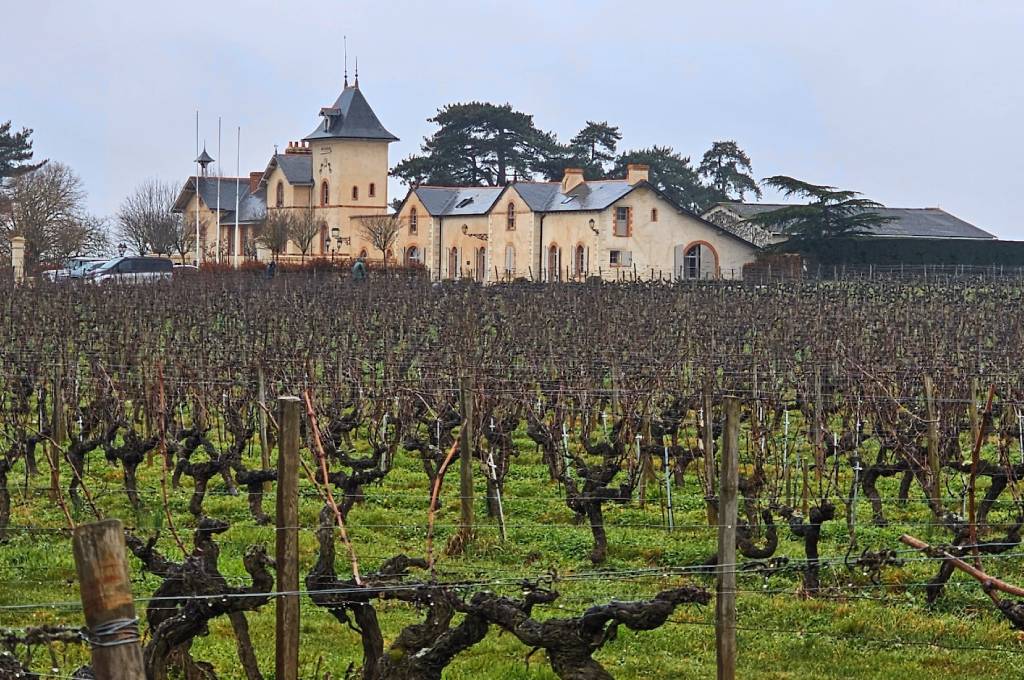 The viticultural domaine is part of the Château Soucherie which was originally a farm owned by the Duke of Brissac. He built this château as a leisure place. In 2007 the château was acquired by Roger-François Béguinot, who made his fortune in infant nutrition. The beautiful château and the winery sit on a high point above the Layon river. The 70 acres of vineyards are immediately around the château on gentle south-facing slopes running down to the river. The soils are various types of schist. Grape varieties planted are Gamay, Grolleau, Cabernet Franc for the reds and Chenin (94%) and Chardonnay (6%) for the whites. The view from the château over the valley down to the Layon river is breathtakingly gorgeous. The viticultural domaine is part of the Château Soucherie which was originally a farm owned by the Duke of Brissac. He built this château as a leisure place. In 2007 the château was acquired by Roger-François Béguinot, who made his fortune in infant nutrition. The beautiful château and the winery sit on a high point above the Layon river. The 70 acres of vineyards are immediately around the château on gentle south-facing slopes running down to the river. The soils are various types of schist. Grape varieties planted are Gamay, Grolleau, Cabernet Franc for the reds and Chenin (94%) and Chardonnay (6%) for the whites. The view from the château over the valley down to the Layon river is breathtakingly gorgeous. |
LUNCHWine pairing light lunch at Château Soucherie.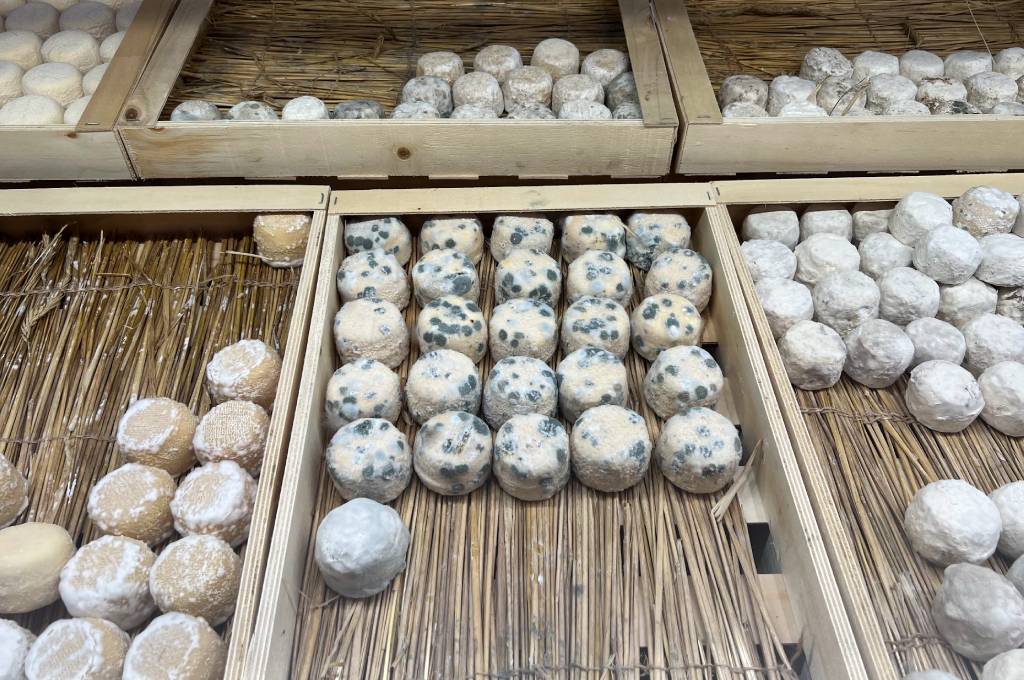
The wines of Domaine de la Soucherie will be accompanied by charcuterie and local cheeses. The Loire is a paradise for cheese mongers! Some of the great cheeses of France are produced in this region. |
Visit at Clotilde Legrand - Domaine Legrand in Varrains, Anjou.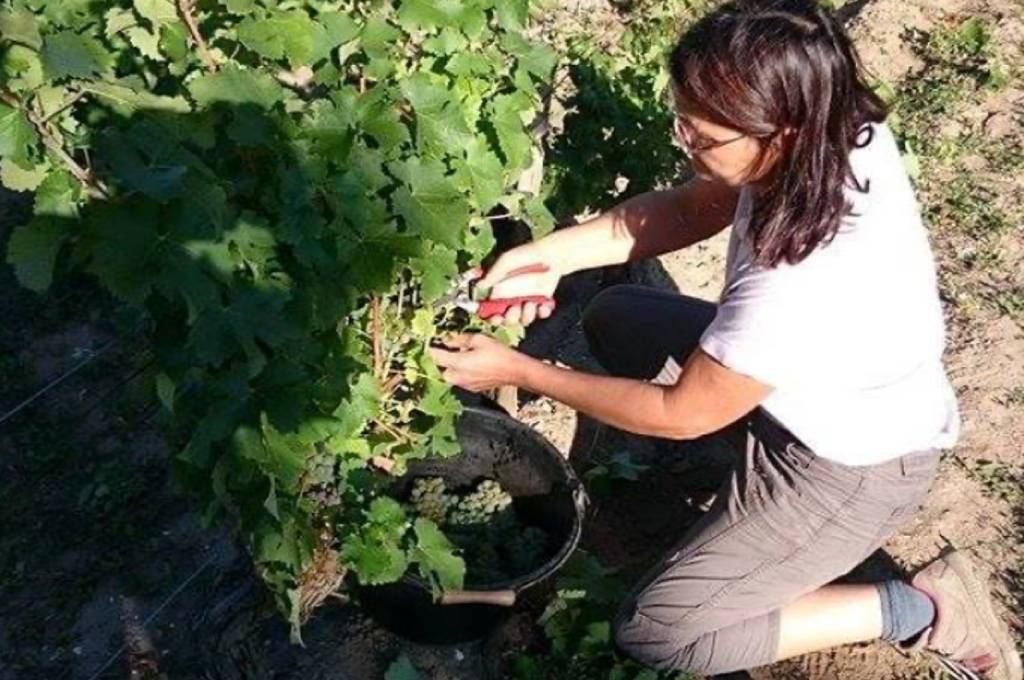
The Legrand family can trace its wine grower history back to the 17th century. In 2014 the first women – Clotilde Legrand – took over and has since become an icon in the Saumur-Champigny appellation. The domaine farms 44 acres, mostly planted with Cabernet-Franc, and a tiny parcel with Chenin Blanc. The vineyards are divided into about twenty plots spread out over the villages of Saumur, Dampierre, Chacé, Varrains, and Souzay-Champigny. The average age of the vines is 45 years, with the oldest being planted in 1927. The soils are clay-limestone and these produce the best Saumur-Champigny wines. In Saumur, the vines grow on gentle slopes which are traditionally enclosed by walls, hence a “Clos”. These tufa (the local name) walls ensure optimal maturation of the grapes through their protection and brightness. All fruit is harvested manually, fermentation is spontaneously, followed by malolactic fermentation and ageing 2 to 4 years in French oak of which is 1/3 new. The vinification is done without adding sulfites. There is no fining and filtering before bottling. |
EVENINGArrival and Check in at Hôtel Mercure Bords de Loire in Saumur.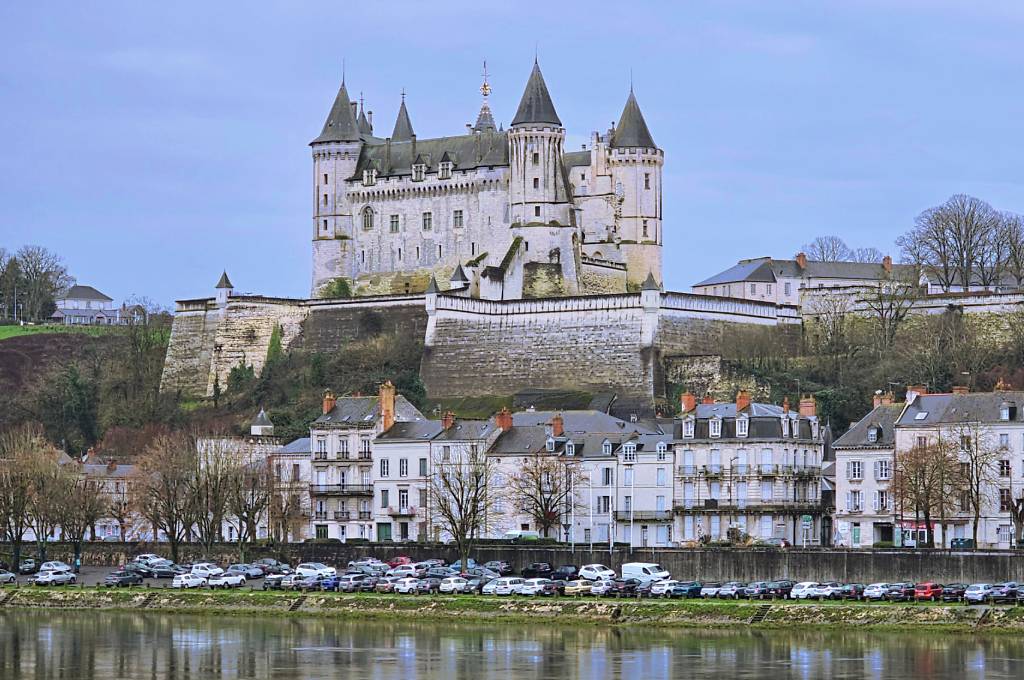
From our hotel we have a fantastic view towards the Château de Saumur and the town of Saumur. Saumur is an incredibly cute town at the confluence of the Loire and Thouet rivers worth exploring. The pretty Château dates from the 14th century, but Saumur is most known for its excellent cavalry school with its Cadre Noir, a counterpart of the Spanish riding school in the Hofburg in Vienna, its Crémant de Loire wines, and mushroom cultivation. |
DINNER at restaurant L'Essentiel in Saumur.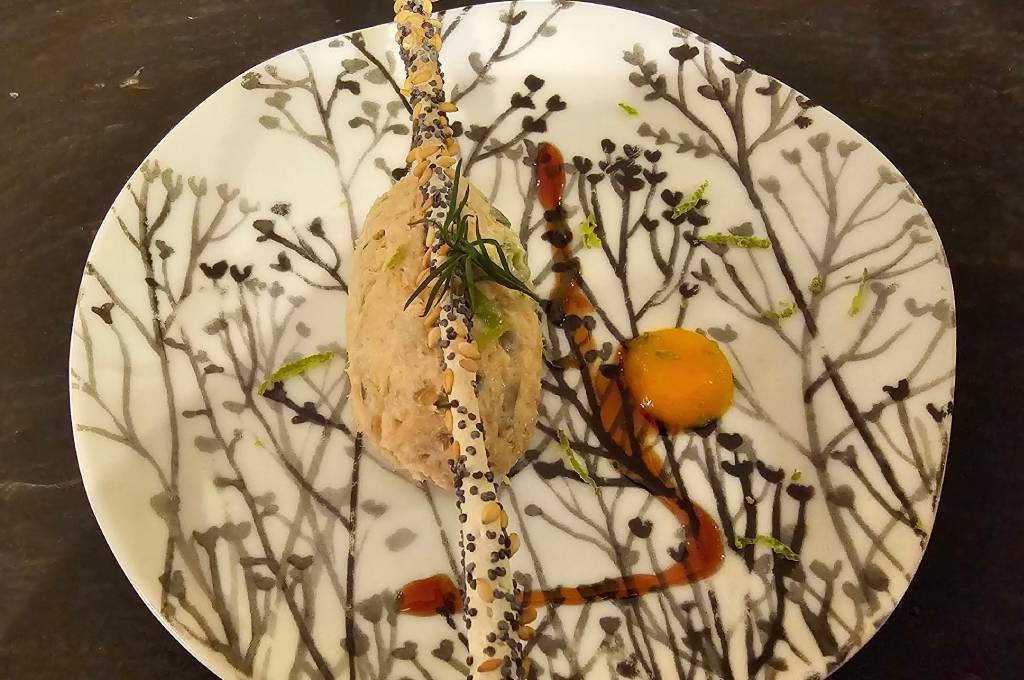
This unassuming small restaurant is just fantastic: no chi-chi, an honest, refined cuisine: wonderful! |
DAY 5: Thursday, June 13 |
MORNINGGuided visit of the Abbey of Fontevraud.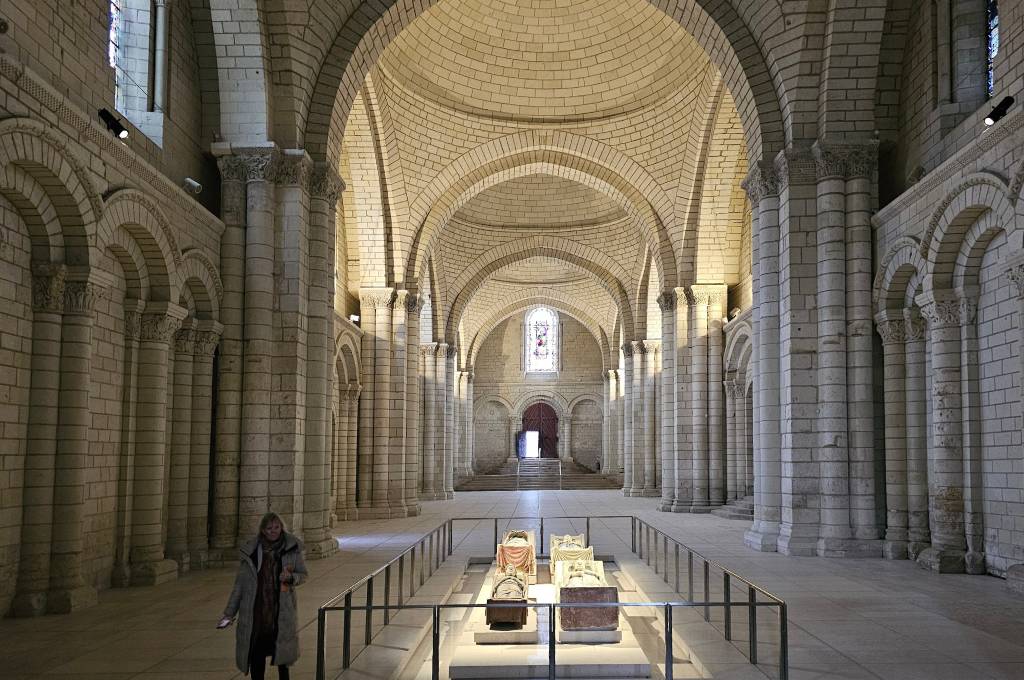
This majestic abbey and the monastic order “Order Fontevraud” was founded by a preacher in 1101. The order was recognized as a religious community by the Bishop of Angers. It was a unique order as it was a double monastery: there were nuns and monks following the same rules. The French revolution put an end to the monastery. Luckily, for a long time the buildings served as prison and that saved the monastery from dilapidation. Still today the monastery is of high historic relevance: we will pay a visit to the tombs of the Plantagenêts who like no others shaped Frances’ history: The union of Henry II, Duke of Anjou, later the king of England and most powerful ruler of the Middle Ages, married Eleonor of Aquitaine, herself one of the most powerful women of her time. Because of this union large parts of France came under English rule – for wine lovers: Bordeaux and the Loire Valley were English for 300 years. Henry II, his wife and their two sons Richard Lionheart and John Lackland and daughter-in-law Isabella of Angoulême are buried here. |
LUNCHLunch at L'Orangerie Saumur - Le Bistro du Château.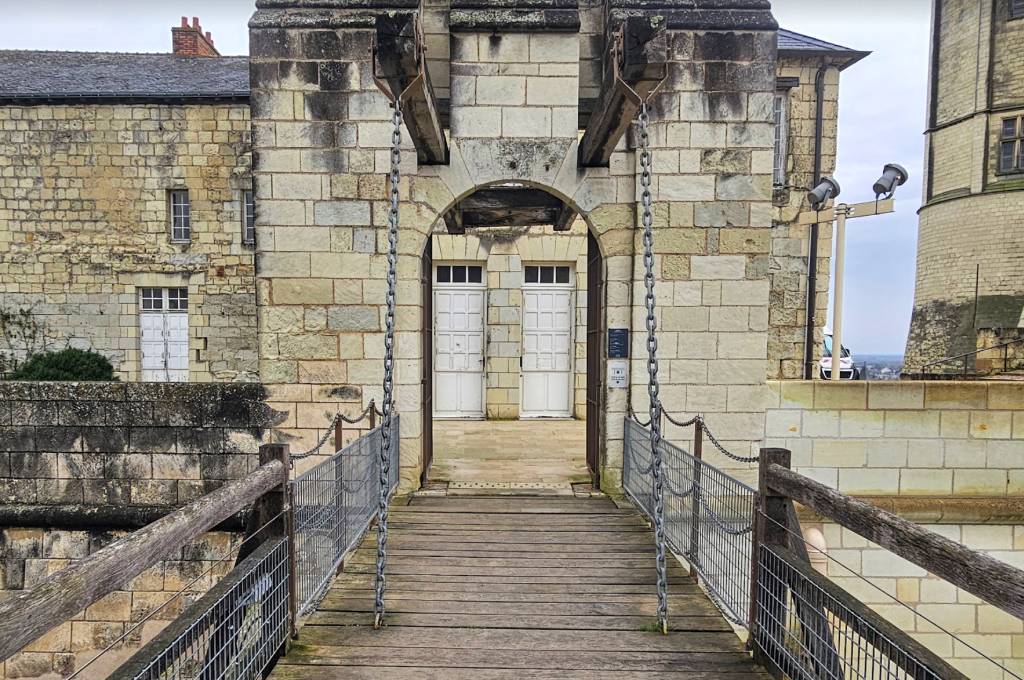
L’orangerie is a traditional bistro located in an exceptional setting, the courtyard of the Château de Saumur – the origins of the château go back to the 10th century -on the top of the hill above Saumur. Enjoy great views of the historic heart of the city and the panorama of the Loire and its valley, listed as UNESCO world heritage site. |
AFTERNOONVisit at Domaine des Roches Neuves in Varrains, Anjou.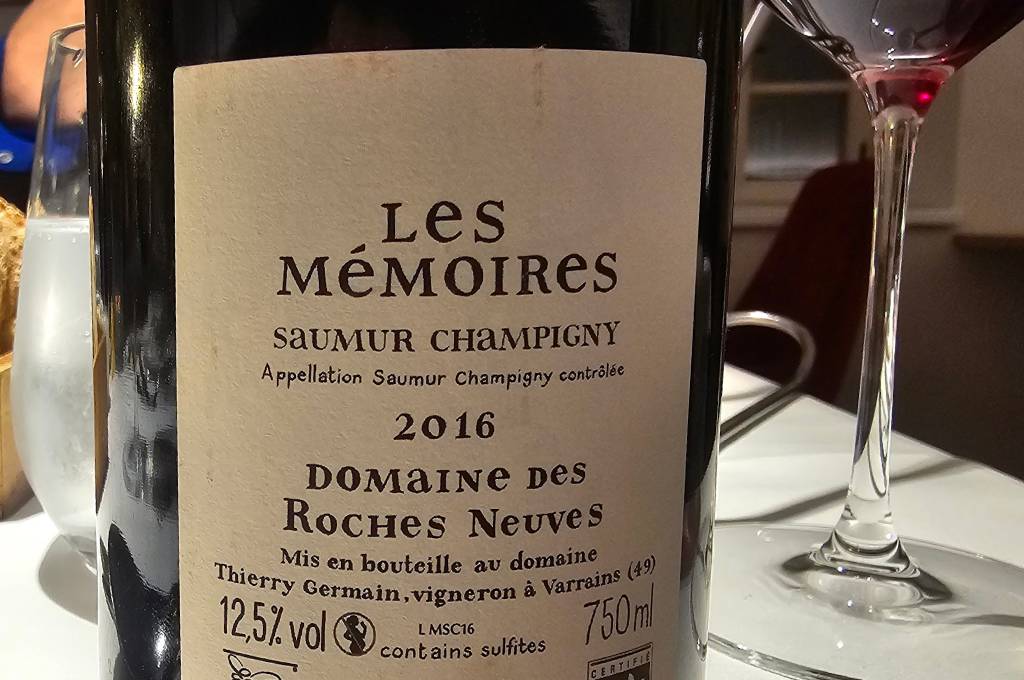
Owner of this domaine of 70 acres is Thierry Germain. I quote our friend and importer of fine wines Heiner Lobenberg: “Thierry Germain can, without exaggeration, be counted among the greatest winemakers in the Loire. He masters the diversity of the Loire like only a few others.” Thierry comes from a family of winemakers from Bordeaux. In 1991 he decided to leave Bordeaux since he felt at that time that Bordeaux was boring for him and he started working in the Loire. In 1991 he bought the Domaine des Roches Neuves which was then a tiny winery and built it up to 70 acres. Thierry Germain is passionate about terroir and nature and immediately started to convert to organic viticulture. The domaine is certified biodynamic by Demeter since 2000. I recently had the 2016 Les Mémoires, Cabernet Franc, AOP Saumur-Champigny: just the right tannins, moderate alcohol level, incredibly beautiful floral character. Since then I am in love with the Saumur-Champigny Cabernet-Franc. |
Visit of Maison Bouvet-Ladubay in Saumur, Anjou.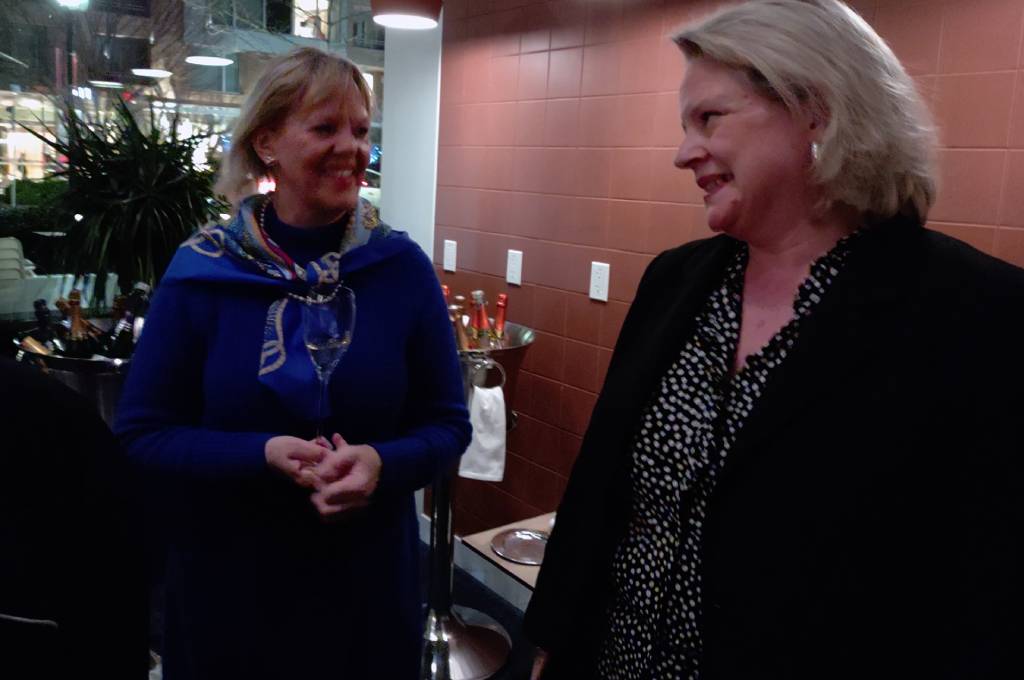
Maison Bouvet-Ladubay is one of France’s greatest producers of méthode traditionnelle sparkling wine. It is also one of the oldest sparkling wine producers in the Loire valley with a history of more than 170 years. In 1851 Etienne Bouvet and his wife, Celestine Ladubay purchased 8 km of underground tunnels in Saumur with the intention of turning them into cellars. By the 1870s, Etienne was exporting his wines to England, became an official supplier to the House of Lords, and had built a majestic château, a theater, and his own power plant to serve the estate. At the turn of the 19th / 20th century Bouvet Ladubay was one of the largest sparkling wine producers in the world with an annual production of 7 mio. bottles. The couple did not have any direct heirs and after their death the Monmousseau family acquired the estate. Today it is Juliette Monmousseau who runs the business. French wine law dictates that “Crémant” must be produced in the traditional method and that the bottles need to age a minimum of 9 months on the lees before disgorgement. Very often the Crémant spend many more months on the lees to enhance quality. |
Evening and dinner on your own.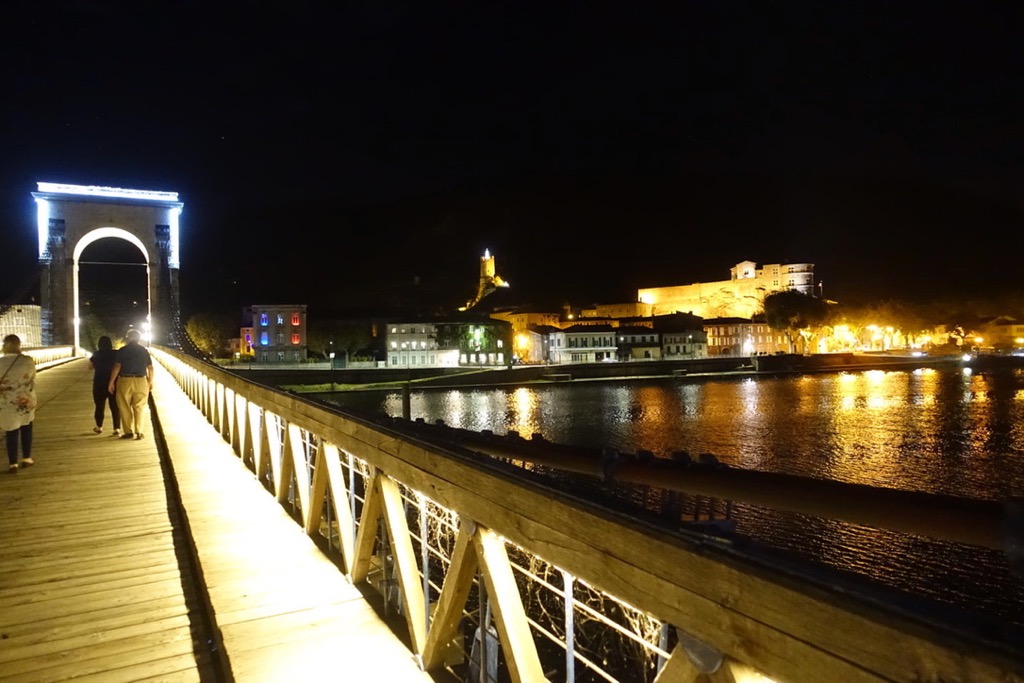
Explore the lovely town of Saumur. There are many bistros, brasseries, restaurants to choose from. |
DAY 6: Friday, June 14 |
| The next four days we divide our time between focusing on wine and history, i.e. visiting a few Loire Châteaux where history was written. It is fascinating how events taking place at some of these châteaux shaped France’s and eventually Europe’s course of history. We move on to the Touraine region. The Touraine wine region is the Loire Valley’s most diverse subregion. The climate is continental and the terroir is enormously varied: from chalky tuffeau to flinty-clay, some sands and gravels from the river’s deposits. Main grape varieties are Chenin Blanc and Cabernet Franc, but also lots of fantastic Gamay, and Côt -the local name for Malbec-. Delicious wines are produced from autochthone varieties such as Romorantin for whites, and Grolleau and Pineau d’Aunis for reds. The most well-known appellations are Vouvray -always from Chenin Blanc- and Chinon for red wines. |
Today is our "Chinon" day.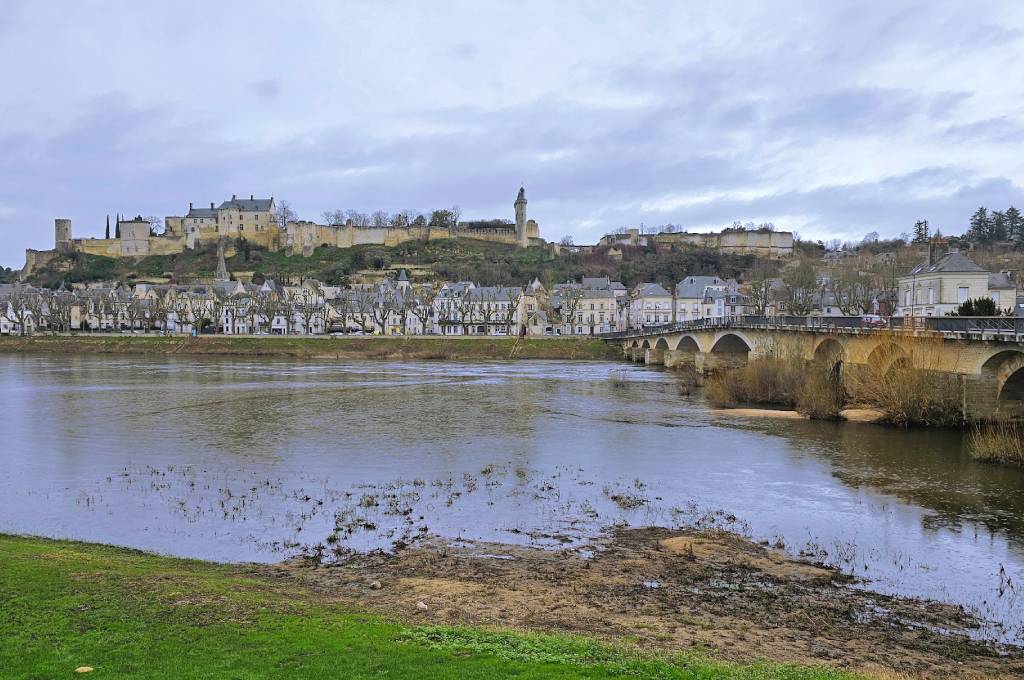
Today we focus on wines from the AOP Chinon. The river Chinon is next to is not the Loire, it is the Vienne, a tributary of the Loire originating south of Chinon in the Auvergne mountains. The medieval town of Chinon is also very important: it is steeped in decisive events having shaped the course of history in France. On the border between the three historical regions of Anjou, Poitou, and Touraine, the fortress-castle occupied a strategic place that was hotly contested in ancient times. From its rocky spur it dominates the entire territory, but also several centuries of history. It was here where the Plantagenêt court of Henry II. and Eleanor of Aquitaine was held and where Henry II. and his son Richard Lionheart died. Much later, in 1429 Joan of Arc met here with King Charles VII. to ask for providing her with an army to defeat the English which eventually ended the 100 year war and gave the territories north of the Loire and the Bordelais back to France after 300 years under English rule |
MORNINGVisit at Cave M. Plouzeau in Chinon, Touraine.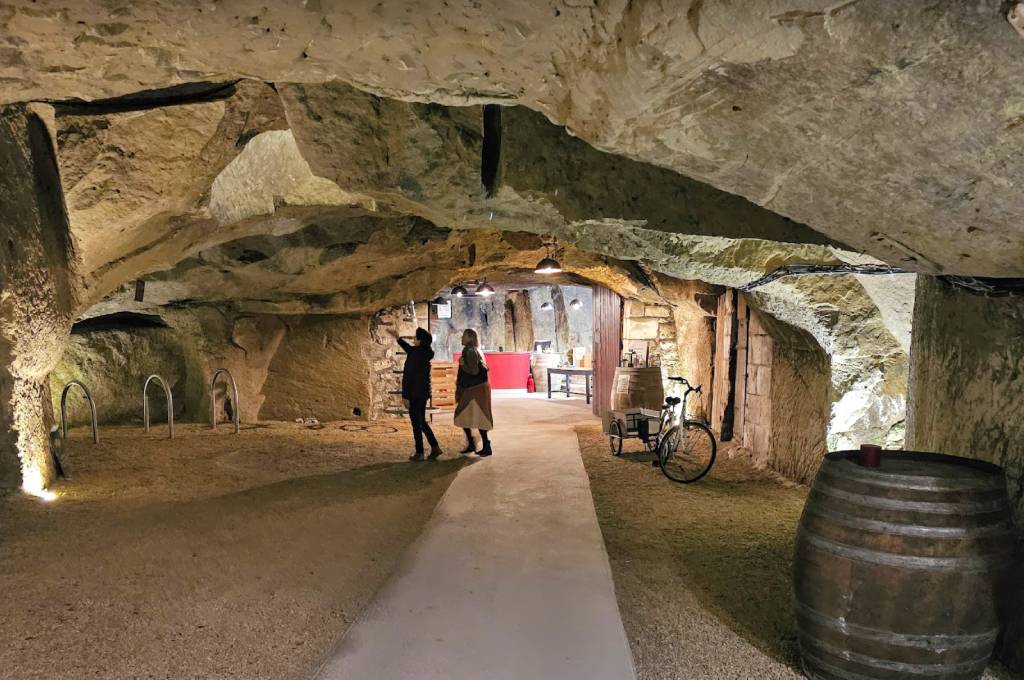
In 1846 the Plouzeau family acquires Château de la Bonnelière on the left bank of the Loire river near Chinon. Pierre Plouzeau replanted the neglected vineyards in 1980. A winery was constructed at Château de la Bonnelière in 1989. Marc Plouzeau took over in 1999 and converted to organic viticulture. His wines are aged in a unique space: the cellars under the fortress of Chinon. Here, in these caves, hewn from limestone in the 12th century, the Plouzeau wines mature in oak or concrete eggs and the bottles are also stored in these caves. I quote Marc Plouzeau: “Our cellars under the fortress of Chinon are a major asset for an optimal breeding. Our mono-parcellaires improve slowly in half-muids, at a constant temperature of 12° C and at high hygrometry. In these conditions, our wines are refined and stabilize naturally. The winemaking techniques are ancestral but use all the modernity that allows to preserve the best potential of grapes.” We will have a tasting of the Plouzeau wines in these incredible caves and Marc will tell us everything about his idea of winemaking. |
Visit at Domaine de la Haut Olive in Chinon, Touraine.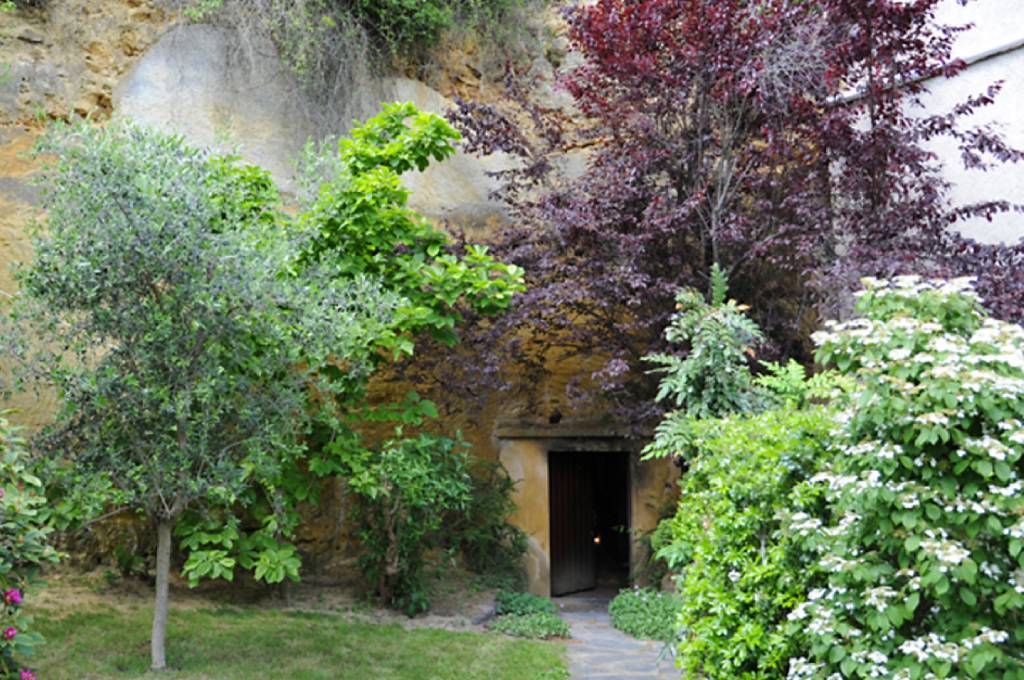
Schatzi Wines, the importer of the Domaine de la Haut Olive wines into the US has a fabulous write up on the domaine: “The Sourdais family have been making wine at their original domaine, Bouchardière, in Cravant les Côteaux – just east of the small town of Chinon - since its founding around 1850. Ownership has been passed from father to son over six generations; Bruno Sourdais has led the domaine since 1991. Domaine de la Haute Olive, established in 1913 and now comprising 42 acres, belongs to Sophie’s (Bruno’s spouse) father, Yves Jaillais. Bruno and Sophie have leased the vines and made the wines since 2006. Just within the ambit of Atlantic influence, Cravant les Côteaux’s moderate maritime climate is excellently suited to its cardinal grape: cabernet franc. But at the core of the region’s vinous character is the diversity of its soils. The village takes its name from an old Gallic word for pebbles and the domaine’s holdings encompass sandy, gravelly flood plains of the Vienne river, as well as clay silex and the clay limestone millarge. While the vineyards planted on alluvial soils give fresh, quenching wines, clay and silex slopes produce the fine, subtle wines, and the clay and chalk hill of the superb Le Chêne Vert plot are the source for the most elegant, age-worthy bottles.” |
LUNCHLunch at restaurant Le Lion d'Or in Chinon.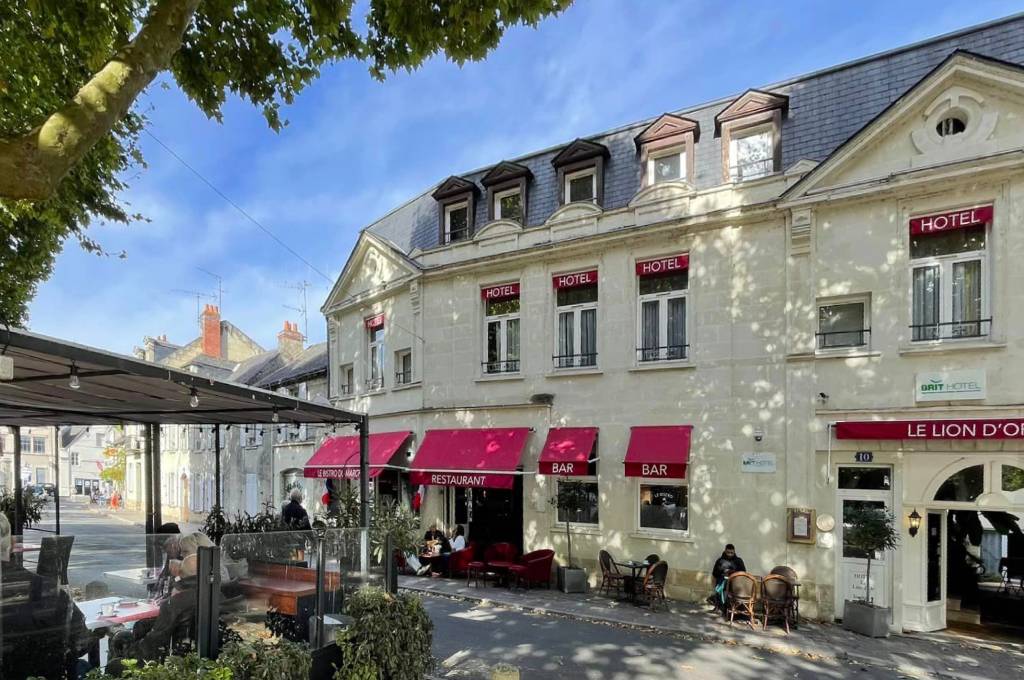
The restaurant sits right in the center of Chinon. We will have a great view of the ruins of the Fortress of Chinon. |
AFTERNOONVisit at Domaine François Bazin, Le Petit Chambord, in Cheverney, Touraine.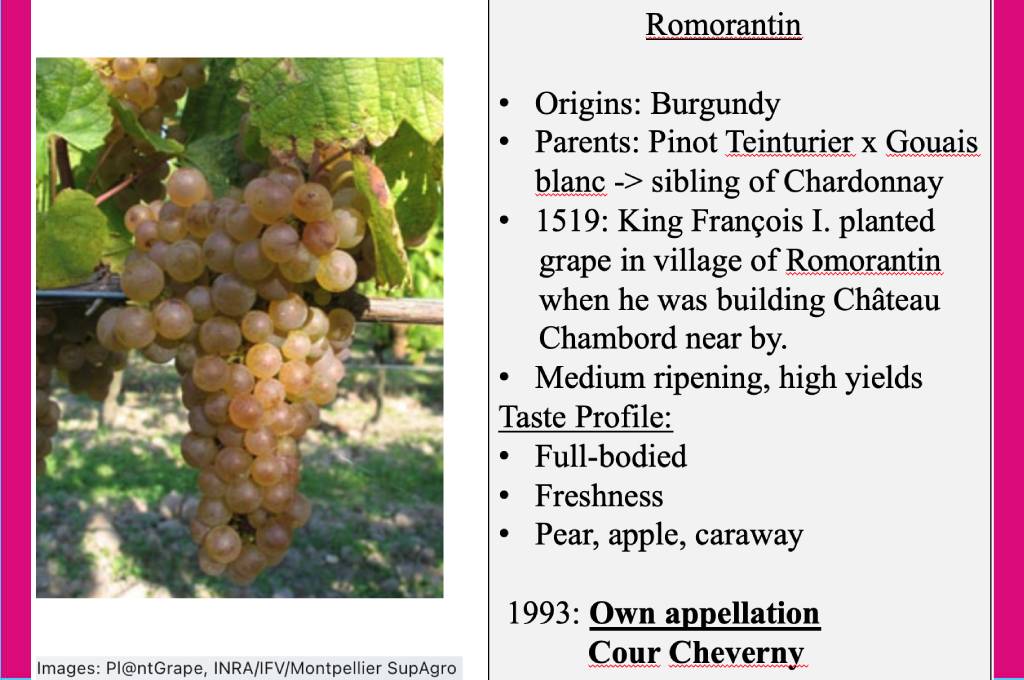
Le Petit Chambord is a family winery, passed down from father to son for four generations. They farm 51 acres in three appellations: Cheverney, white, red, and rosé, Crémant de Loire, and Cour Cheverney. 50% of the vineyards are planted with white grape varieties with Romorantin as the dominant variety. The red varieties are Pinot Noir, Gamay, and Côt (the local term for Malbec). Romorantin gives a full-bodied, but at the same time elegant, fresh wine and is a grape that came from Burgundy to the Loire Valley. It was King François I. who enjoyed Romorantin wines and brought the grape to this area in 1519 when he built the Château Chambord near by. In 1993 Romorantin got its own appellation: the AOP Cour Cheverney is Romorantin only. At this domaine we can taste a wide variety of wines and a quote by Astor Wines in NY says this: “There’s a lot to remember when it comes to the Loire. Novices, take note: Cabernet Franc is a great alternative to Cabernet Sauvignon, Muscadet is unparalleled as a companion to shellfish, and Cour Cheverny is the best white wine appellation you’ve never heard of.” |
EVENINGArrival and check in at Hôtel Mercure Centre in Blois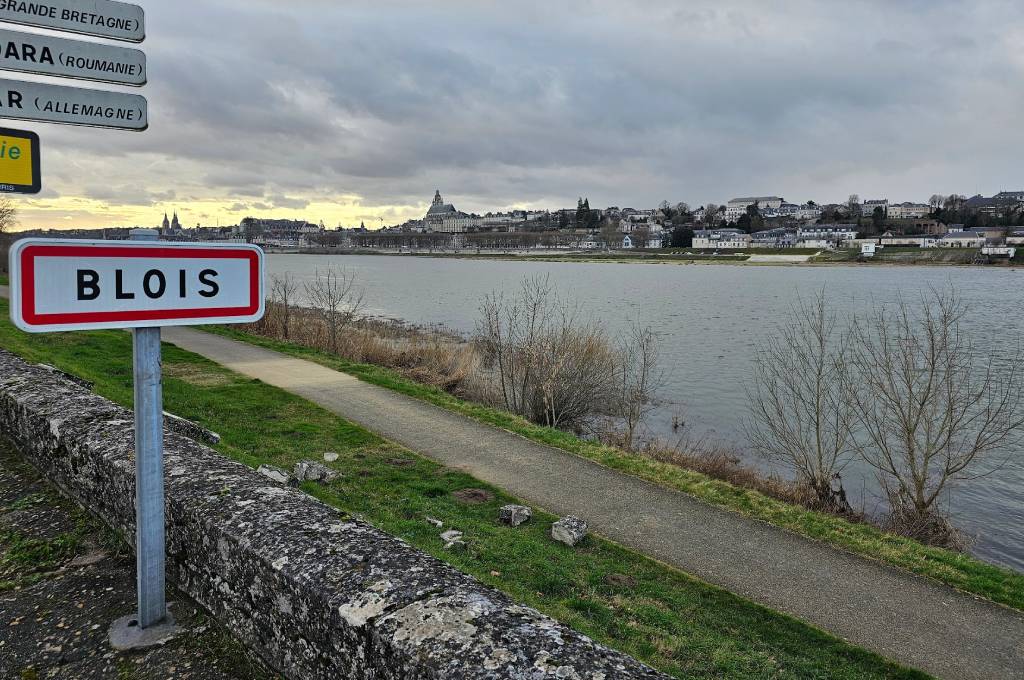
The hotel is nicely located on the Loire river bank but close enough to walk to downtown Blois. |
DINNER at Restaurant Brut Maison de Cuisine in Blois.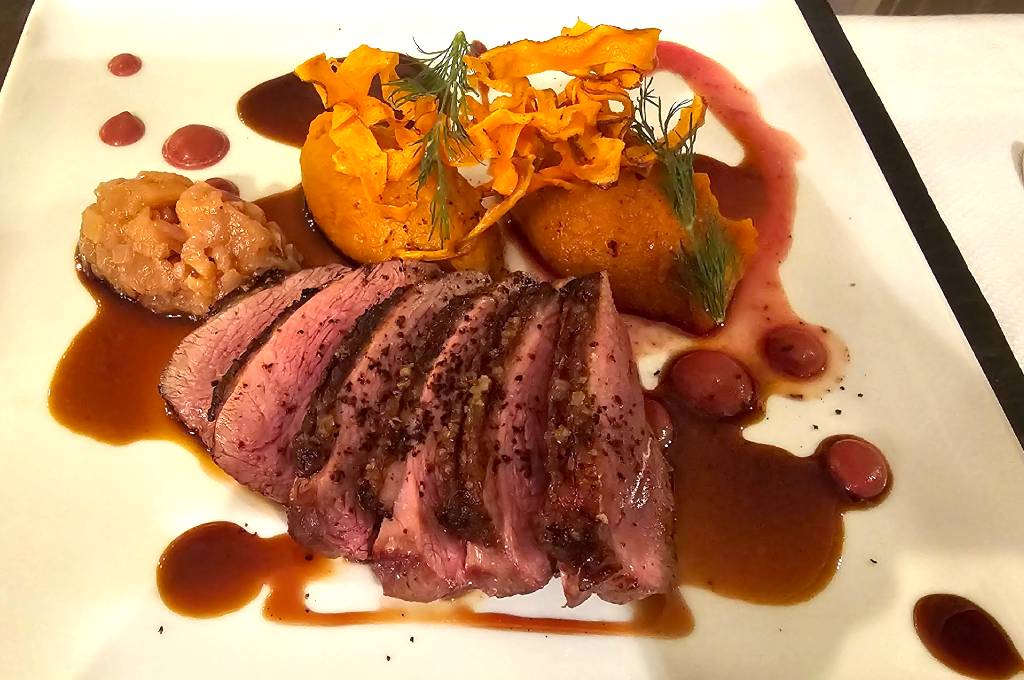
This is a restaurant “bistronomique” with a great view on the Loire river, the Château Royal and the town of Blois on the other side of the river. |
DAY 7: Saturday, June 15 |
MORNINGThis morning we discover the Vallée du Loir region.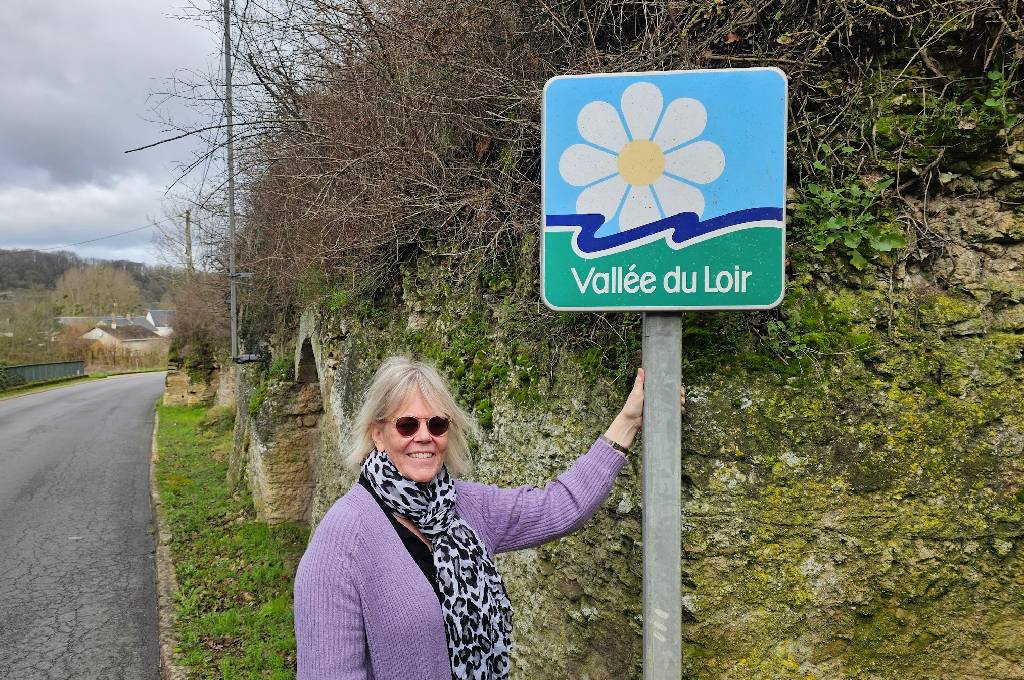
The appellations in the Vallée du Loir (yes: with out an "e", not to be confused with the Vallée de la Loire) belong to the lesser-known regions and are hidden gems. There are three appellations: Côteaux du Loir, Jasnières, Côteaux du Vendômois. |
Visit of Domaine Braziliér in Thoré-la-Rochette, Vendômois, Touraine.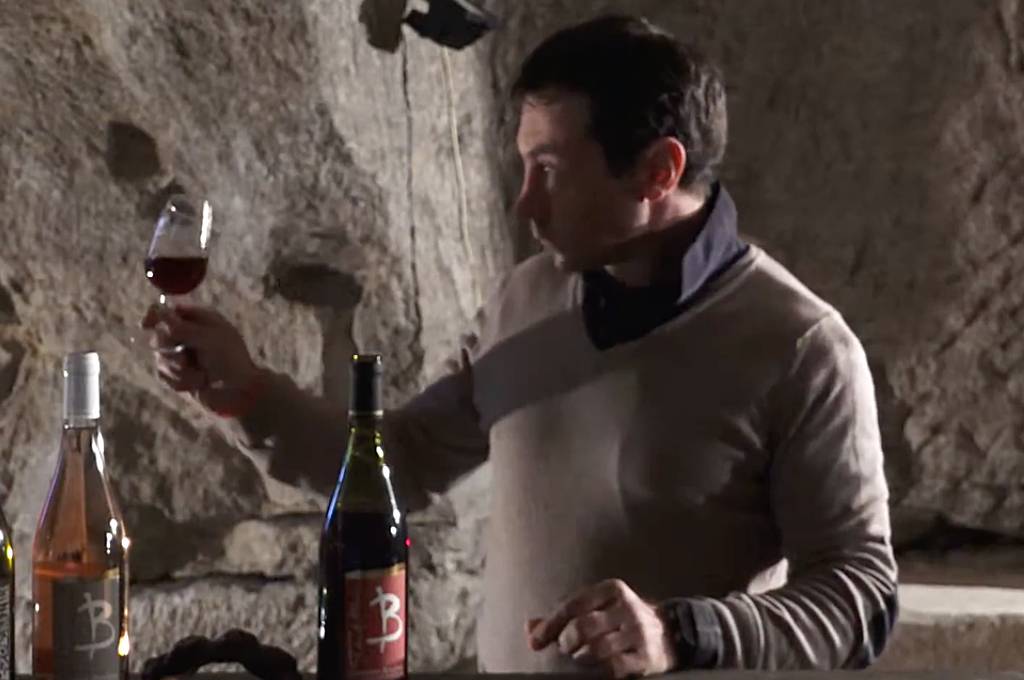
Current owner and winemaker is Benoît Brazilier, the 7th generation of a family of winegrowers and winemakers in Thoré-la-Rochette in the Vendômois. This region is situated in the valley of the Loir river, one of the few tributaries of the Loire originating in the north between Le Mans and Paris. The wines of this region have a historic reputation but were overlooked for a long time. In 2000 the Vendômois was granted AOP Côteaux du Vendômois status. This regions gains more and more attention because of the fantastic wines produced here. Domaine Brazilier has 65 acres of vineyards planted with mainly Chenin and Pinot d’Aunis, an autochthone red grape variety in the Loire valley as well as Cabernet Franc and Pinot Noir. They work the fields with respect for the environment and are certified Terra Vitis. The soil is typical for the Touraine region: chalky limestone with some flint, called “tuffeau”. Benoît uses historic limestone caves for much of his wine production and the tasting room. These caves were carved out centuries ago when the rocks were used to build the châteaux. |
LUNCHLunch at restaurant Le Moulin du Loir in Vendôme.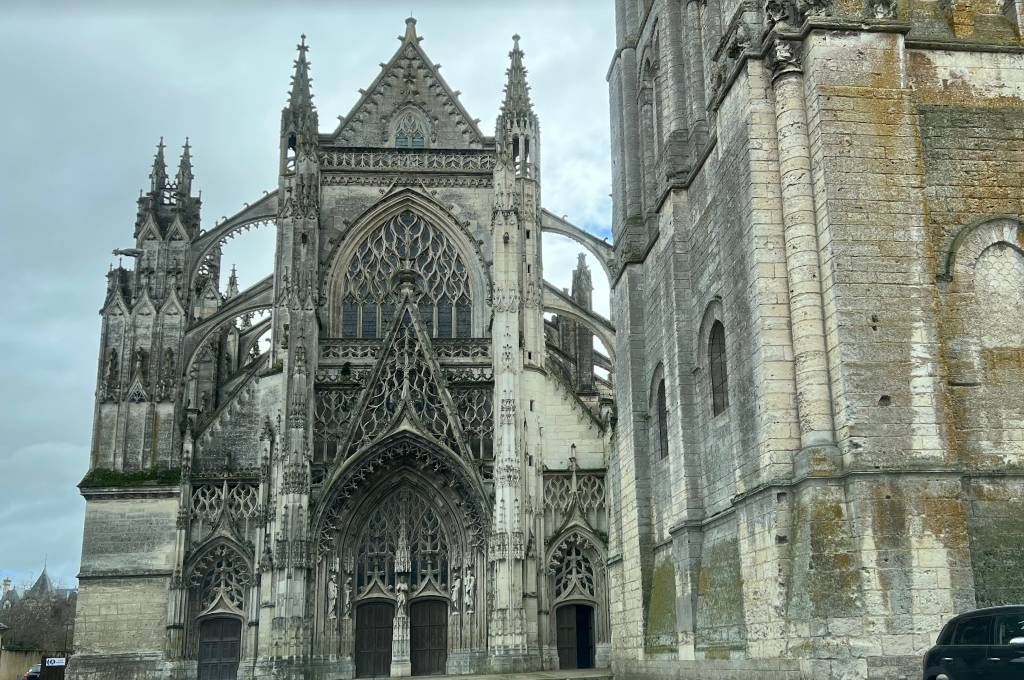
To visit the town of Vendôme is worth a detour. We have time to visit the beautiful Trinity Abbey church and its incredible flamboyant Gothic facade. The monastery was founded in 1035 and was under the direct authority of the Pope in those days. This village restaurant sits over an old wooden mill in the Loir river. There is a nice terrace overlooking the water. |
AFTERNOONGuided tour of Château Chambord.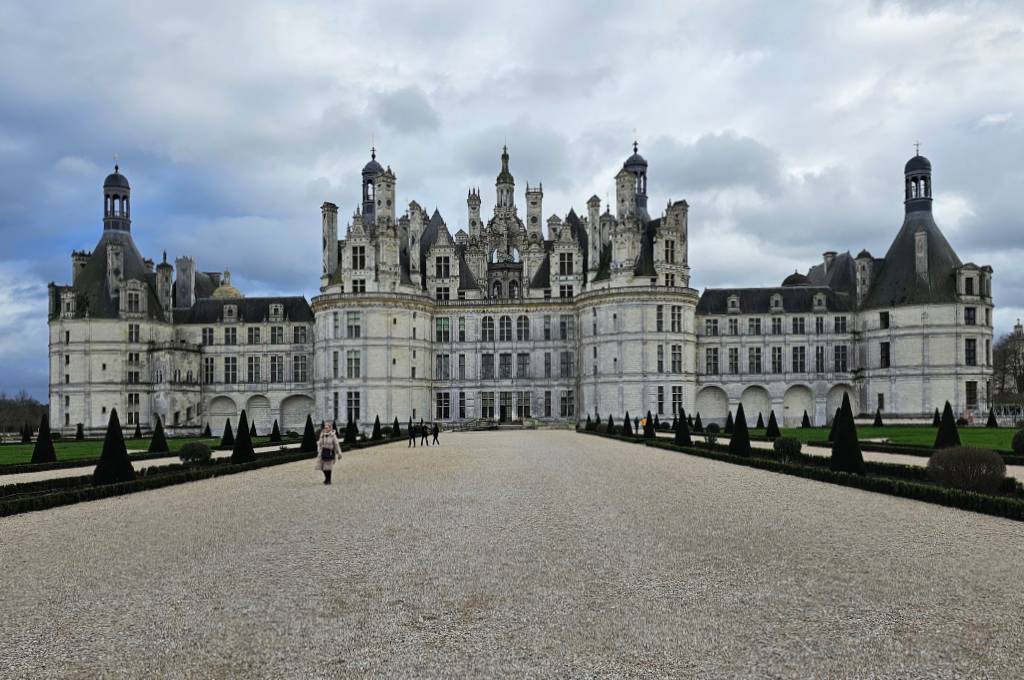
Château Chambord was built by François I. in the 16th century. It is the largest and most known Loire Château and also the most unusual one. With its 400 rooms, it never served as a residential palace, but rather as an impressive backdrop for State Visits. Charles V., Emperor of the Holy Roman Empire of German Nations, commented after a stay: “an epitome of what human art can produce." |
Horse and Pray Show at Château Chambord.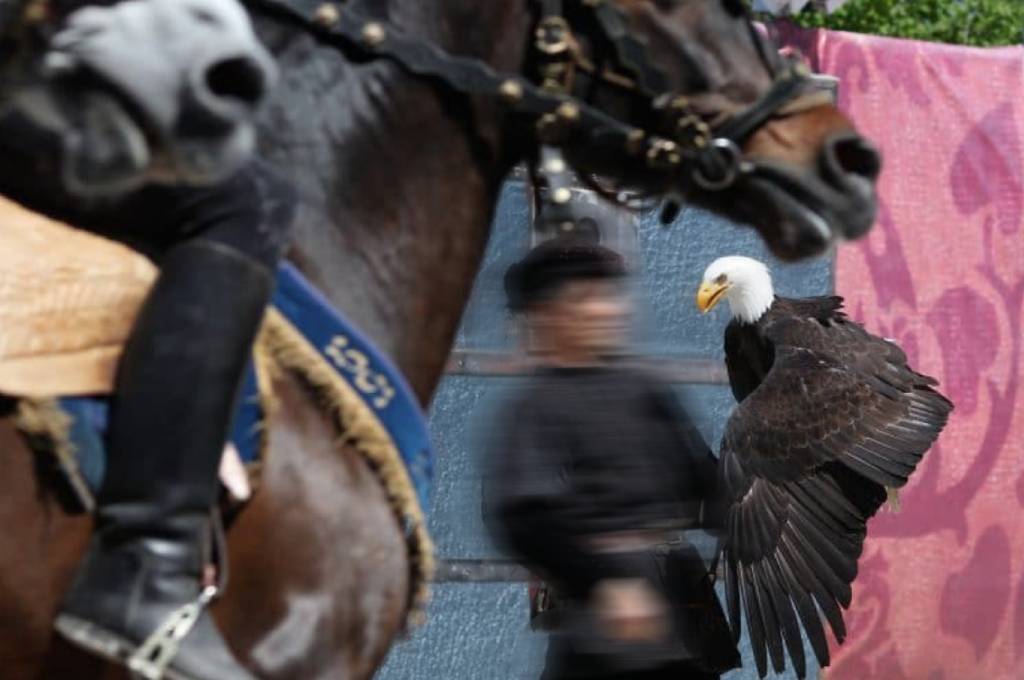
“In the stables of the Maréchal de Saxe, the audience embarks on a grand cavalcade to the rhythm of the horses. Birds of prey brush against the visitors’ shoulders and the show plunges them into the atmosphere of the court of François I.: his reign holds no secrets for them.” Quote Château Chambord. |
EVENINGEvening and dinner on your own. |
DAY 8: Sunday, June 16 |
MORNINGGuided tour of Château Royal de Blois.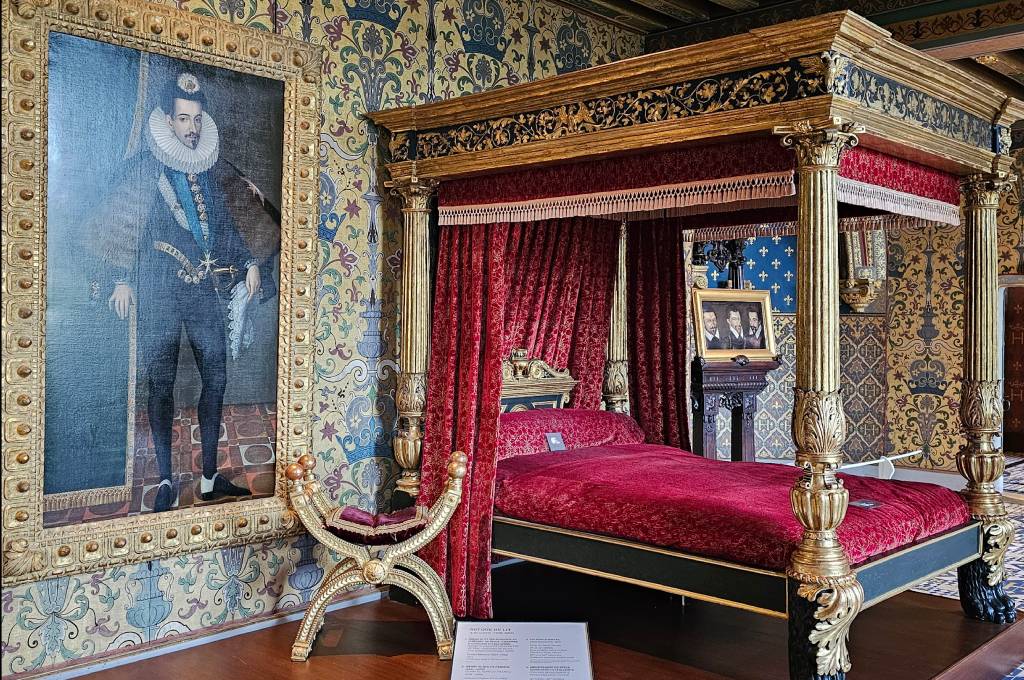
Seven kings and ten queens lived at this place. This Château is a synthesis of all Loire Châteaux. Its four sides are all different. On the walls you can read the history of French architecture from Louis IV to Louis XII. The Château is also the scene of the drama of Blois: the assassination of the Duke de Guise instigated by Katharina de Medici because she thought him becoming too powerful: high point of the religious wars between the Catholics and Protestants which ravaged France in the second half of the sixteenth century. This château is interesting to visit: to get an idea on court etiquette, to look at design in Renaissance times, and because people actually lived here. |
LUNCHLunch at restaurant La Croix Blanche in Veuves Commune de Veuzain-sur-Loire.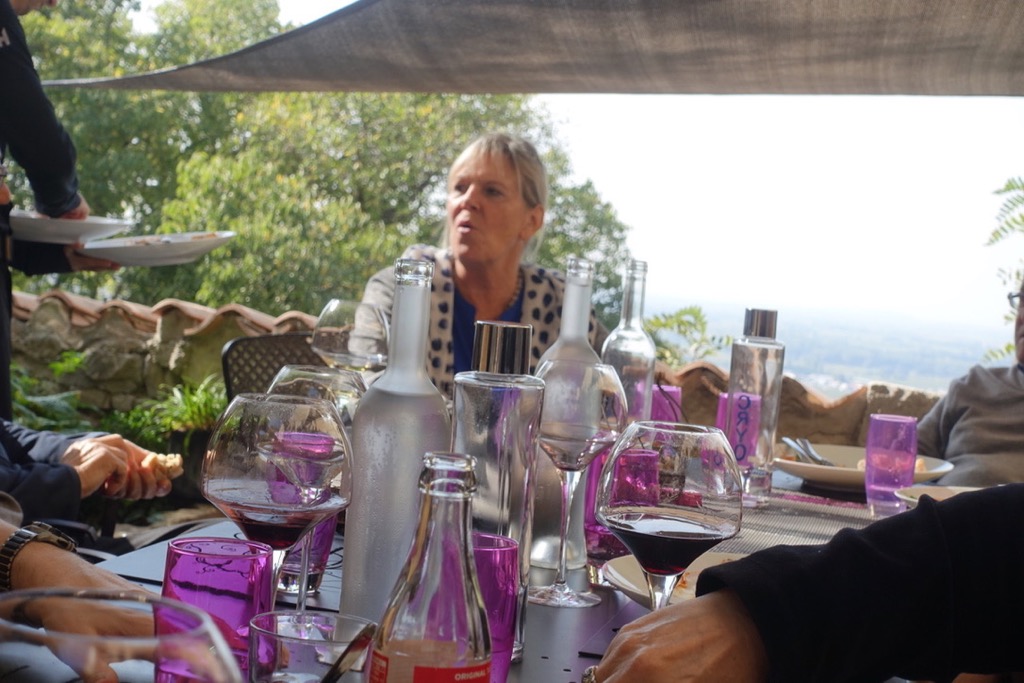
This restaurant has a Bib Gourmand in the Michelin guide. I quote the guide:” At this former coaching inn, you can enjoy the modern cuisine of chef Jean-François Beauduin, who learned his trade in Michelin-starred restaurants. His tempting menu abounds with wonderfully indulgent treats, which does not preclude finesse – the warm duck and foie gras pâté, shredded Brussels sprouts and langoustine sauce is a case in point. Seasonal and local ingredients are de rigueur. Note the selection of more traditional dishes, such as beuchelle tourangelle (creamed kidneys and sweetbreads). Charming service courtesy of the chef's wife, in a delightfully rustic setting. The pleasant terrace in the shade of mulberry trees is a real highlight.” |
AFTERNOONThe town of Amboise. Discover the town on your own.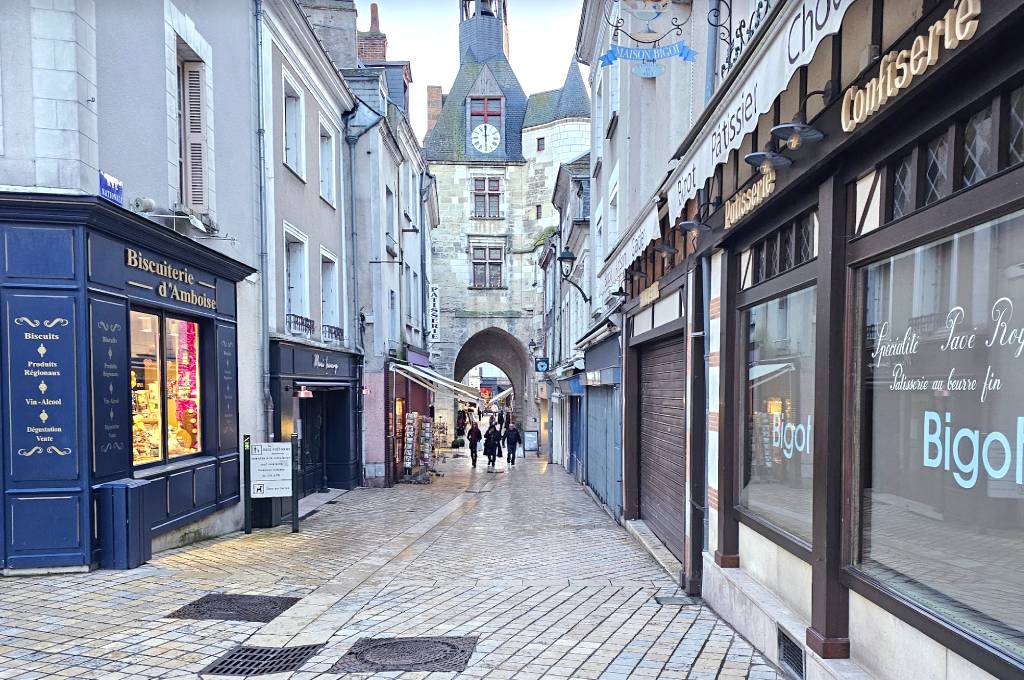
Time to discover the small town of Amboise on your own. The impressive Château Royal d’Amboise is regarded as the cradle of the Renaissance in France and French history was written here for over a century. Five kings of France resided in the Château d’Amboise. Under King Charles III. and his wife Anne of Brittany, Italian splendor and enlightened thinking unfolded here. The metamorphosis from a feudal fortress to a Renaissance palace dates back to this era and the triumpf of the Renaissance began here. Much later, in 1560 during the religious wars an unimaginably horrific bloodbath that lasted several days occurred at the château when Catholics brutally killed hundreds of Protestants. |
Guided visit of Château du Clos Lucé and the Leonardo da Vinci Park.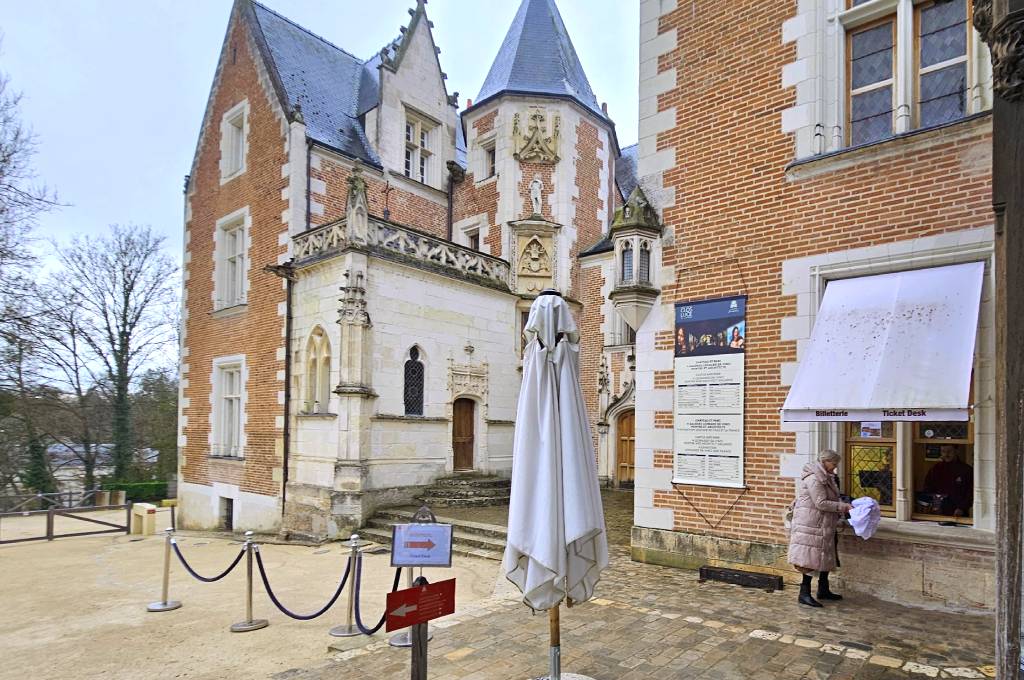
King François I. was fascinated with Leonardo da Vinci and has lured the genius to Amboise with three convincing arguments: a castle at his sole disposal, a monthly pension, and -most importantly- the promise of artistic freedom. Leonardo da Vinci spent his last three years at this château before he passed away in his bedroom on May 2, 1519. An interactive cours runs through the park, impressively showcasing the genius’s many visions. |
EVENINGArrival and check in at Château de Pray in Amboise.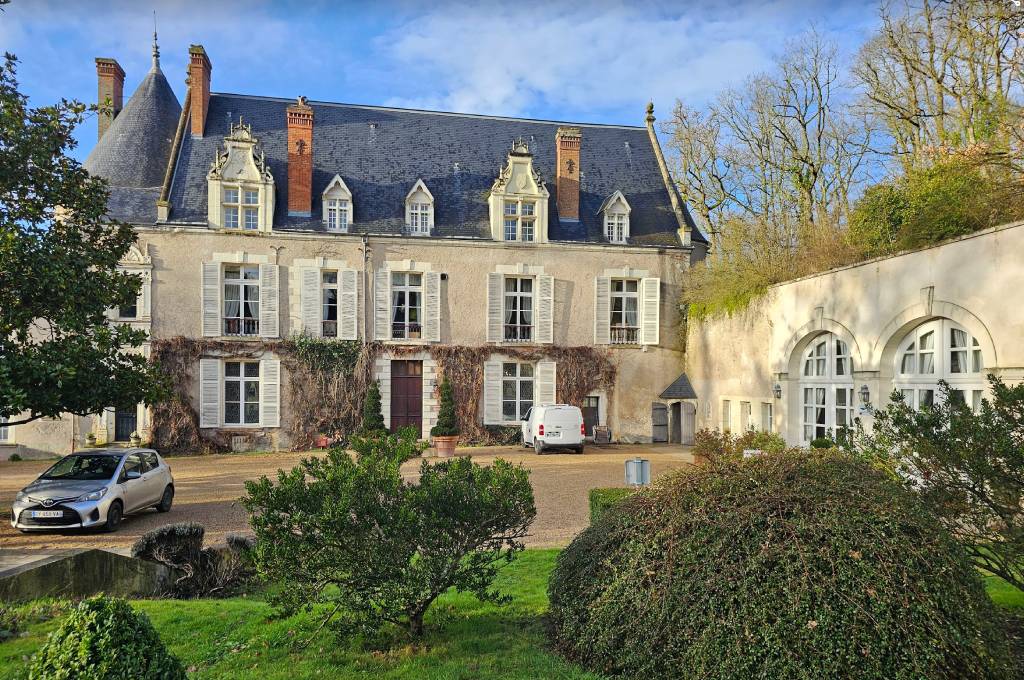
As soon as we step into this beautiful Château – close to the town of Amboise - with its gorgeous garden we leave the modern world behind and get carried back to the glory days of life in the Vallée de la Loire. This authentic Loire Château is still privately owned. It was the first one that was converted to a hotel and restaurant in 1950. In 1992 it achieved its 4-star designation. |
SUPPER at Château de Pray.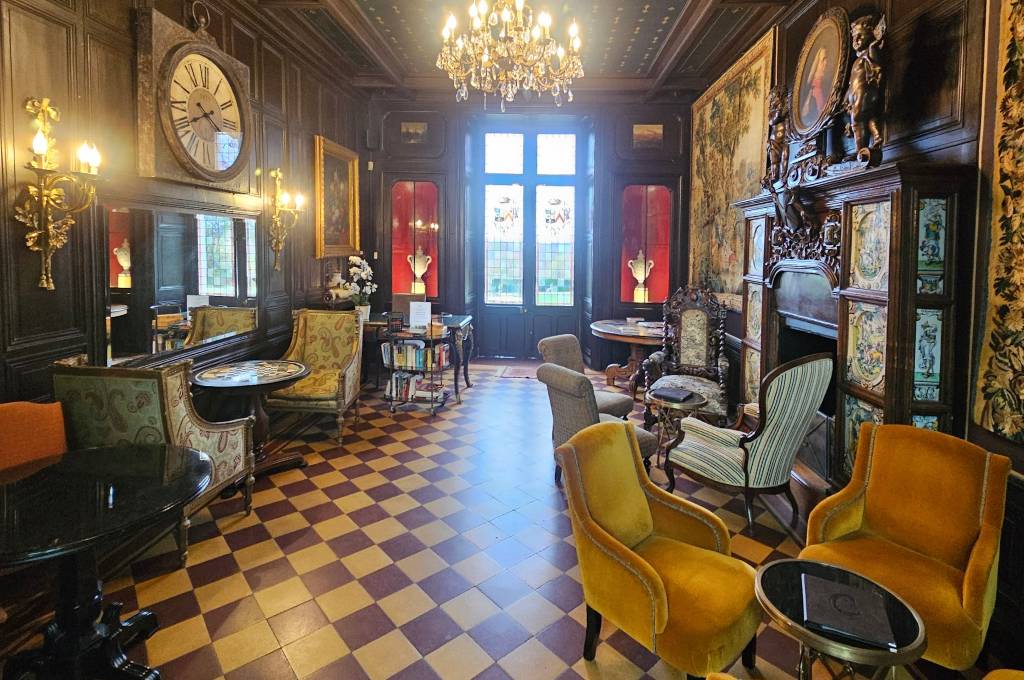
Since the main restaurant is closed on Sundays we get served a light fare on the terrace - weather permitting - or in the beautiful rooms indoors. |
DAY 9: Monday, June 17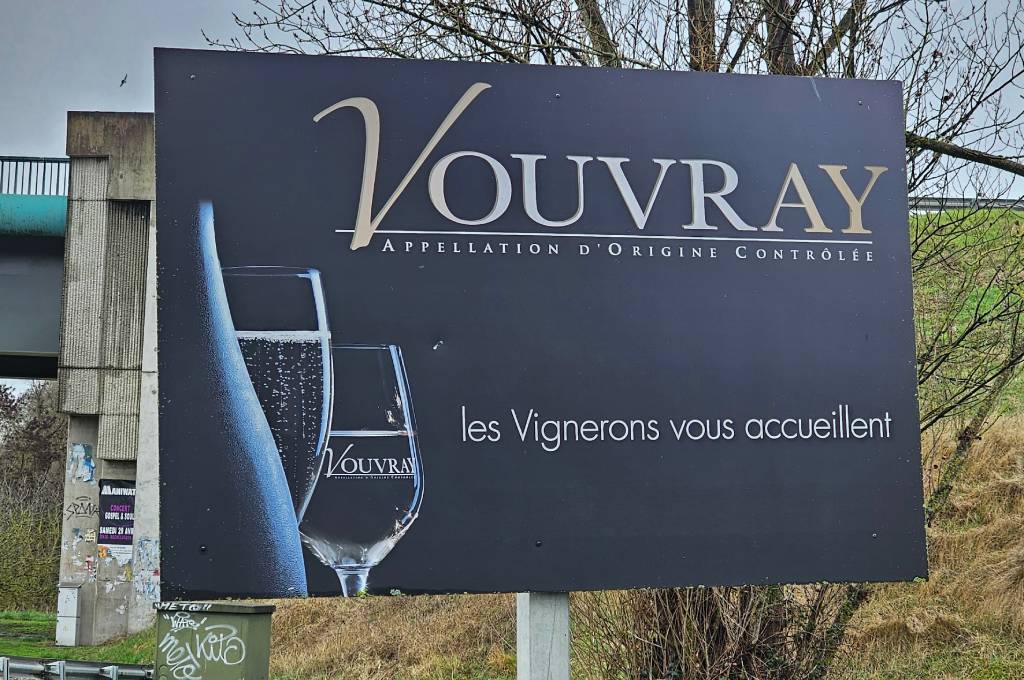 Today we explore the famous Vouvray region. I found the perfect description of Vouvray on Kevin Pike’s Schatzi Wine (one of the great importers to the US of German and other European wines) website: “Vouvray is one of the Loire’s great terroirs for Chenin Blanc. As part of the Paris basin, the soils are largely fossilized marine based. The bedrock, from which the region’s myriad historic cellars are cut, is tuffeau. The topsoils are flinty clay, limestone, gravels, and marls. The climate is marked by the tension between moderate maritime and more extreme continental influences. This, and the fact that Vouvray is traditionally one of the last parts of France to harvest, opens vignerons here to great risk -first, of severe weather, foremost hail (as Denis Meunier experienced in the string of vintages between 2014 and 2016, when he and many around him suffered devastating crop losses), later, of disease. The reward is a cool climate that allows both the acid edge and haunting, subtle depth of chenin to develop to maximum potential. Multiple vineyard passes are key to producing the traditional range of style from sec to moelleux to sparkling. The wines can fall anywhere between austere and opulent, depending on the ripeness and botrytis levels of the vintage.” The Vouvray AOP classification only allows Chenin and Pineau d’Aunis grapes. Today we explore the famous Vouvray region. I found the perfect description of Vouvray on Kevin Pike’s Schatzi Wine (one of the great importers to the US of German and other European wines) website: “Vouvray is one of the Loire’s great terroirs for Chenin Blanc. As part of the Paris basin, the soils are largely fossilized marine based. The bedrock, from which the region’s myriad historic cellars are cut, is tuffeau. The topsoils are flinty clay, limestone, gravels, and marls. The climate is marked by the tension between moderate maritime and more extreme continental influences. This, and the fact that Vouvray is traditionally one of the last parts of France to harvest, opens vignerons here to great risk -first, of severe weather, foremost hail (as Denis Meunier experienced in the string of vintages between 2014 and 2016, when he and many around him suffered devastating crop losses), later, of disease. The reward is a cool climate that allows both the acid edge and haunting, subtle depth of chenin to develop to maximum potential. Multiple vineyard passes are key to producing the traditional range of style from sec to moelleux to sparkling. The wines can fall anywhere between austere and opulent, depending on the ripeness and botrytis levels of the vintage.” The Vouvray AOP classification only allows Chenin and Pineau d’Aunis grapes. |
MORNINGVisit of Domaine Denis Meunier in Vernon-sur-Brenne, Touraine.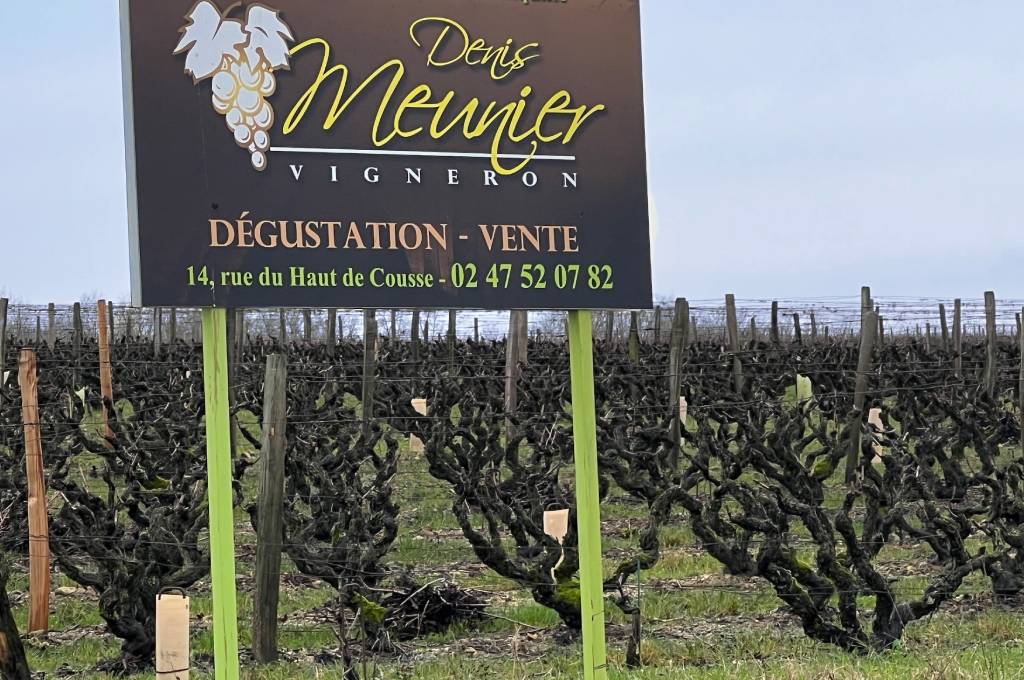
This family winery was founded in 1927. In 2012 third generation Denis Meunier took |
Visit at Domaine des Aubuisières, Bernard Fouquet, in Vouvray, Touraine.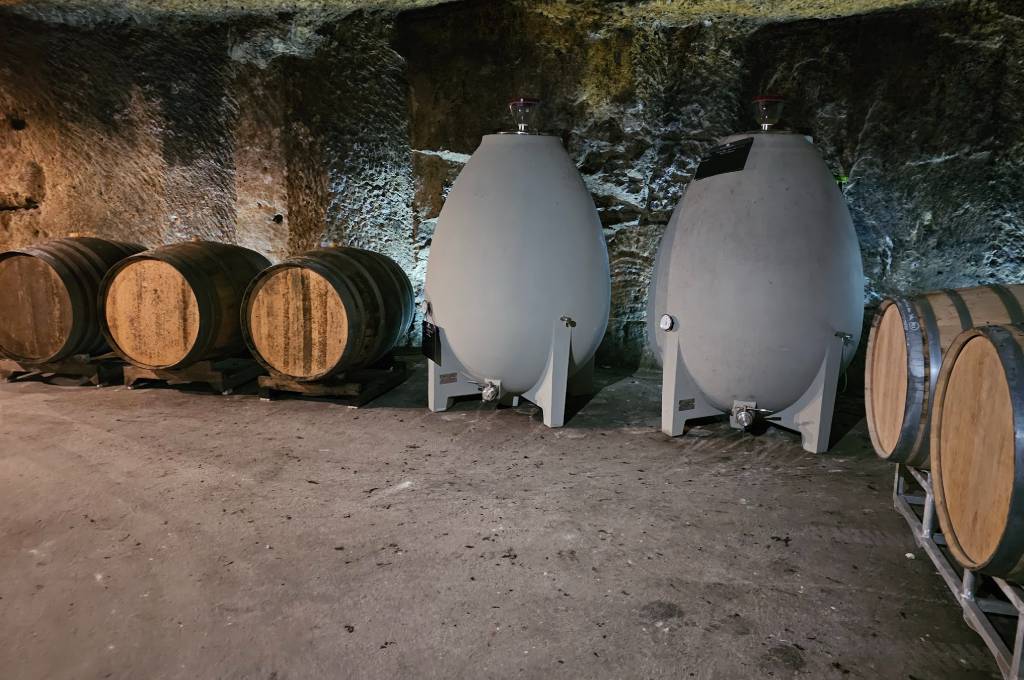
This is one of the top domains in Vouvray. Bernard Fouquet is widely regarded as one of the top Vouvray producers and his ability to capture the mineral tones unique to Vouvray’s soil is legendary. This is a relatively young wine producing domaine, but the Fouquet family was involved in the wine business as grape breeders and grape grafting in their own grape vine nursery. Bernard Fouquet had no interest in continuing the nursery; he wanted to make wine and after stints in Alsace and Burgundy he founded Domaine des Aubuisières in 1982. He crafted a portfolio of superb wines and quickly rose to the top tier winemaker in the region. His children pursued other careers and when Bernard Fouquet fell ill during Covid times, the necessity to find an associate became more pressing. Since 2021 it is Charles Lesaffre, who’s family already had connections to the Fouquet family, who is managing the estate. The domaine has 75 acres of vineyards solely planted with Chenin Blanc. The vineyards have the classic Vouvray terroir: limestone bedrock and superficial flint (Silex in French), and some limestone mixed with fine clay. This combination, particularly when the limestone is the ‘Tuffeau Jaune’ is locally known as ‘aubuis’, hence the name of the domaine. |
LUNCHRestaurant Le Snack, Château Chenonceau.
|
AFTERNOONGuided tour of Château Chenonceau.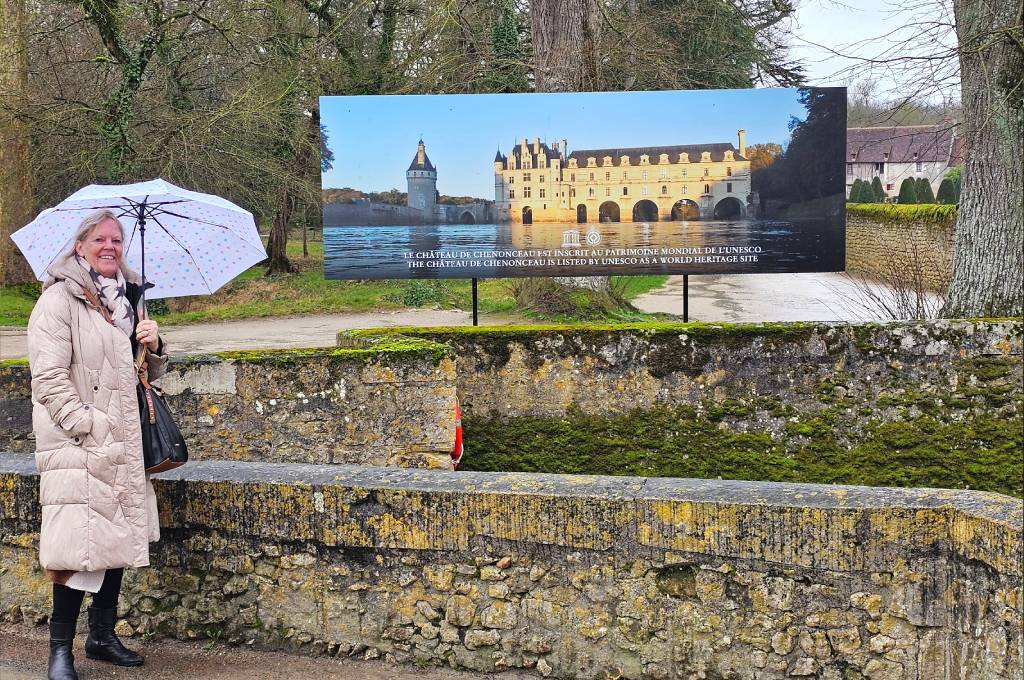
It is the most elegant, most endearing of all the Loire castles. It stretches gracefully across the Cher River, a tributary of the Loire River. Originally it was a mill. The war treasurer of King François I. ordered the castle to be built in 1513. Six women played an important role in the architecture and decoration of the château, the most famous is Diana de Poitier. In 1547 it became the residence of Diana de Poitier, the mistress of Henry II, husband of Katharina de Medici. Chenonceau is one of the few privately owned castles. Since 1913 owner is the family of the chocolate manufacturer Menier. |
EVENINGArrival and check in at Auberge du Bon Laboureur in Chenonceau.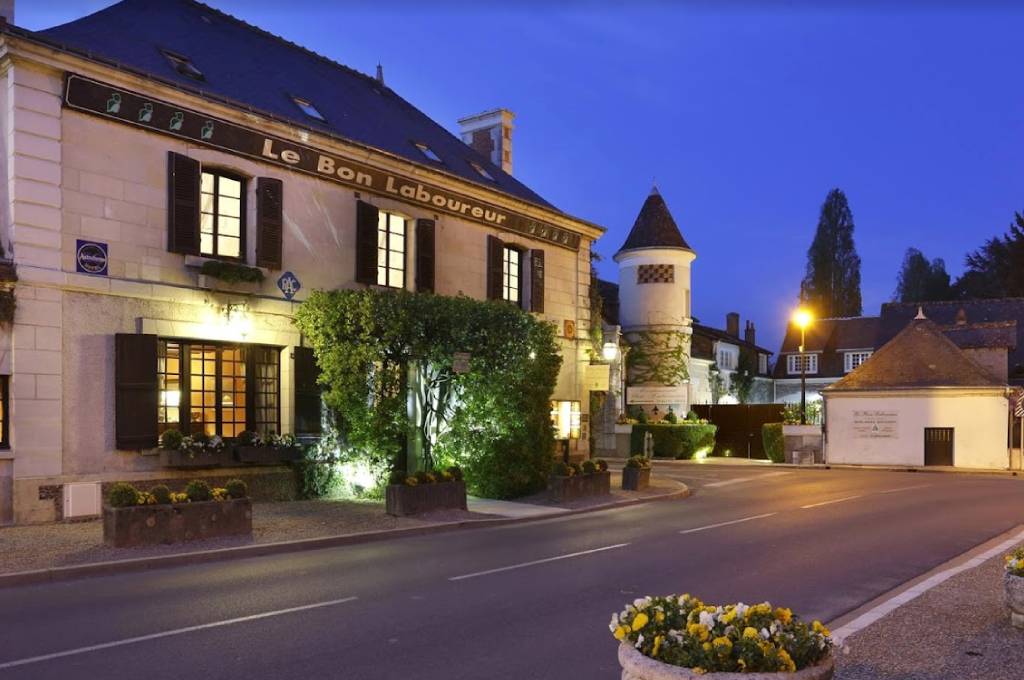
This place is magnificent with completely renovated rooms, a lovely garden, a great heated outdoor pool, a very good restaurant and all amenities of a 5-star hotel |
DINNER at Auberge du Bon Laboureur.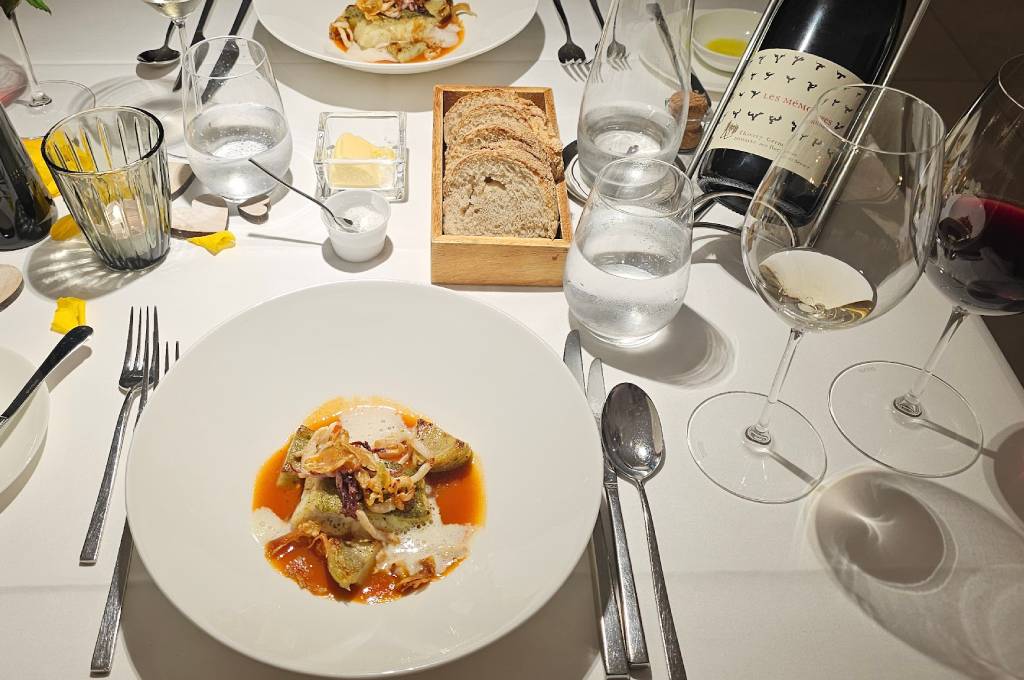
The restaurant is located in an idyllic terrace and garden and the "Chef Antoine Jeudi knows his ranges like the back of his hand, and his tasty creations are accompanied by a nice choice of wines." Guide Michelin |
DAY 10: Tuesday, June 18 |
MORNINGTravel to the Centre region, to Menetou-Salon and Sancerre.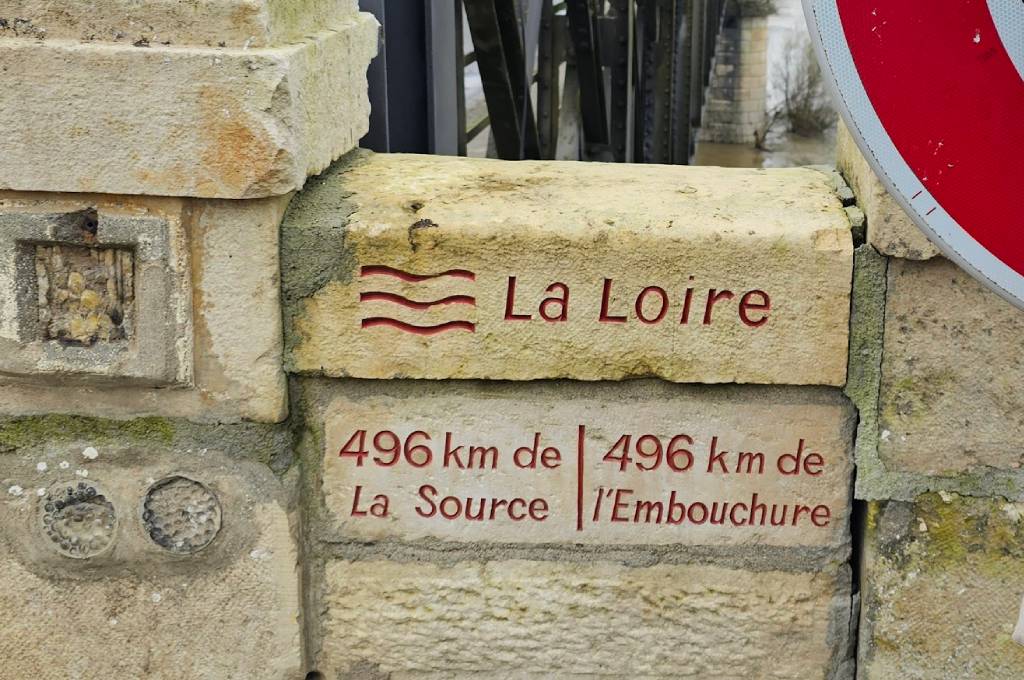
Today we are travelling south-east to the Centre region, to Sancerre. Crispy, gorgeous Sauvignon-Blanc is produced here as well as fantastic reds from grapes such as Pinot Noir, and Gamay. In Sancerre, the eastern side of the Loire river, we find the famous silex soils, which is a type of a compact sedimentary soil that is rich in flint. Silex can have an almost metallic look. On the western side of the Loire River, in Poully-sur-Loire, on the eastern side, we find Kimmeridgian that we know from Chablis, which gives the wines a broader, more mellow character. We will figure out the differences between “Sancerre” and “Pouilly-Fumé”. On the way to Sancerre we stop in Menetou-Salon, a rather unknown appellation to the casual Loire wine drinker producing fantastic Sauvignon-Blanc and Pinot Noir, quality-wise equal to Sancerre or Pouilly-Fumé. When France introduced the AOC classification system, another -now an under-the-radar appellation in this area -Quincy- was the first appellation in France granted the AOC (today AOP) designation in 1936. |
Visit of Domaine Pellé in Morogue, Menetou-Salon, Centre.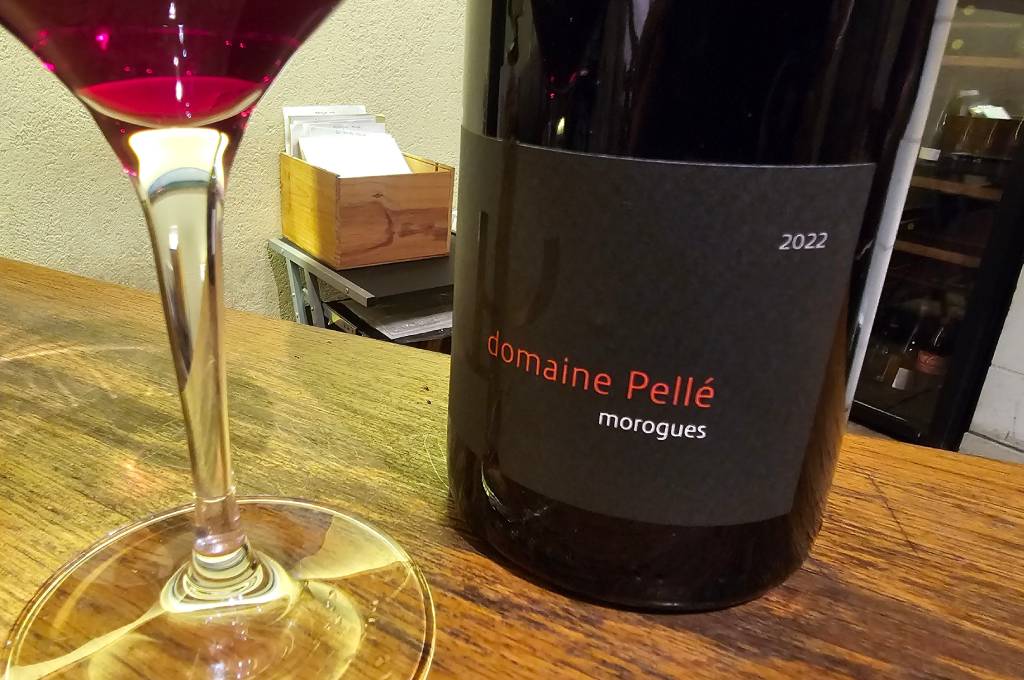
This domain has a 100 year long history of being involved in wine and winemaking in |
LUNCHLunch at restaurant Fluteau in Morogue.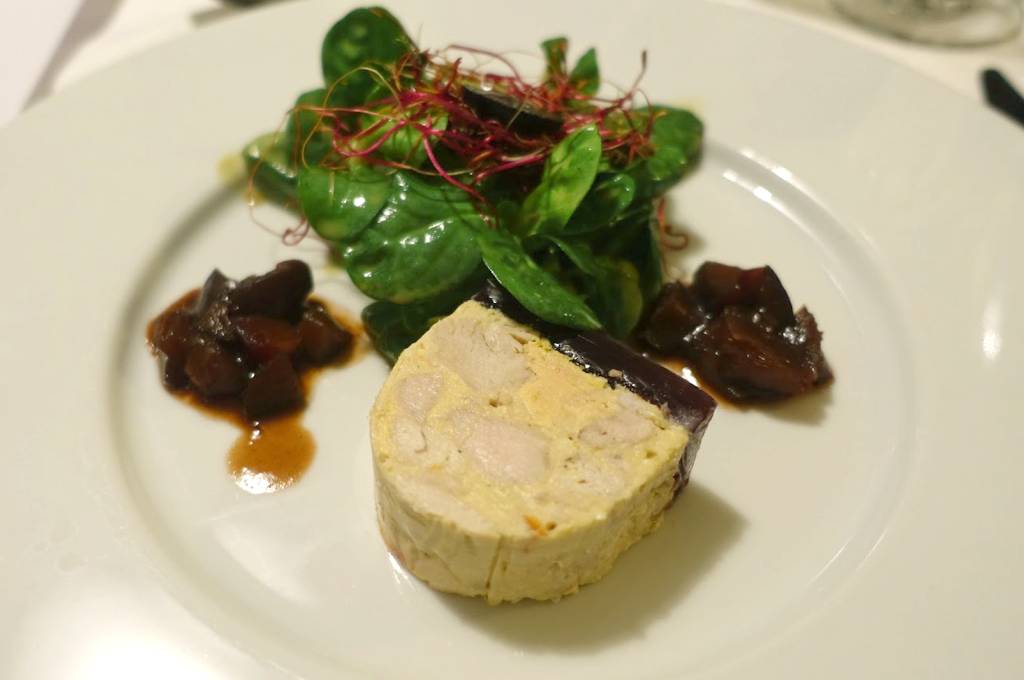
This is a country restaurant with a very warm welcome and excellent local fare. |
AFTERNOONVisit at Vignobles Berthier in Saint Gemme, Centre.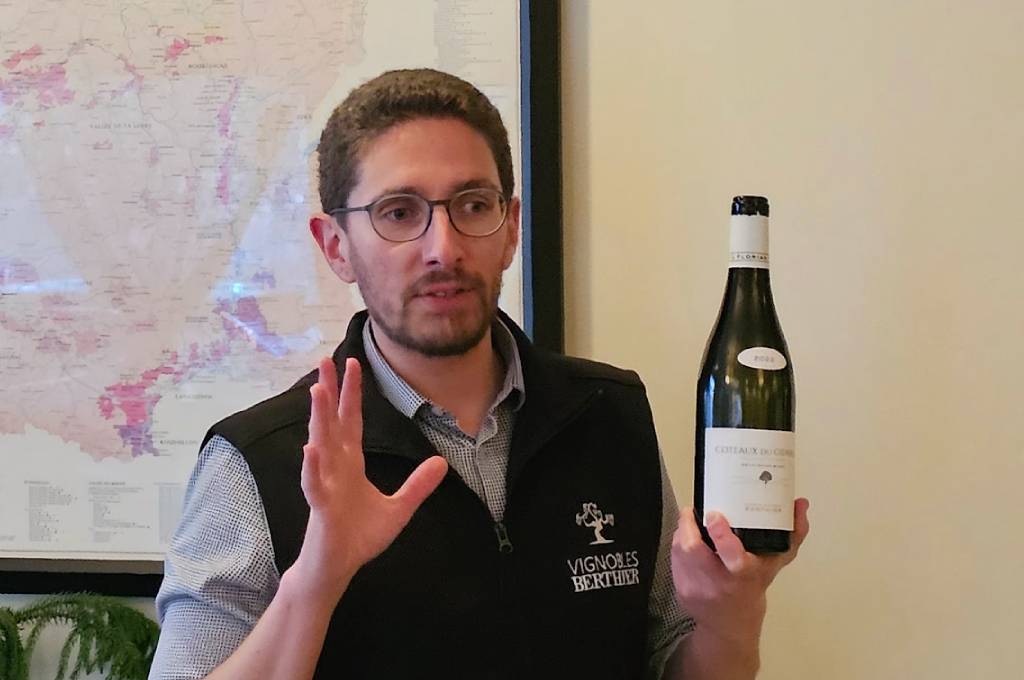
This domaine is now in the hands of the fifth generation of the Berthier family, brothers Clément and Florian Berthier. The vineyards stretch across the Loire river, from one side to the other, from Menetou-Salon, Sancerre to the Côteaux du Giennois, Pouilly-Fumé. The vineyards are planted with Sauvignon Blanc, Pinot Noir, and Gamay. They produce whites in the Sancerre and Côteaux du Giennois appellations and a single varietal Pinot Noir and a blend of Pinot Noir and Gamay. The domaine is certified organic and also uses biodynamic practices. The little known Côteaux du Giennois appellation is a very good choice when it comes to Sauvignon Blanc wines: a very good and less pricey alternative to Sancerre.
|
Visit at Domaine Alphone Mellot in Sancerre.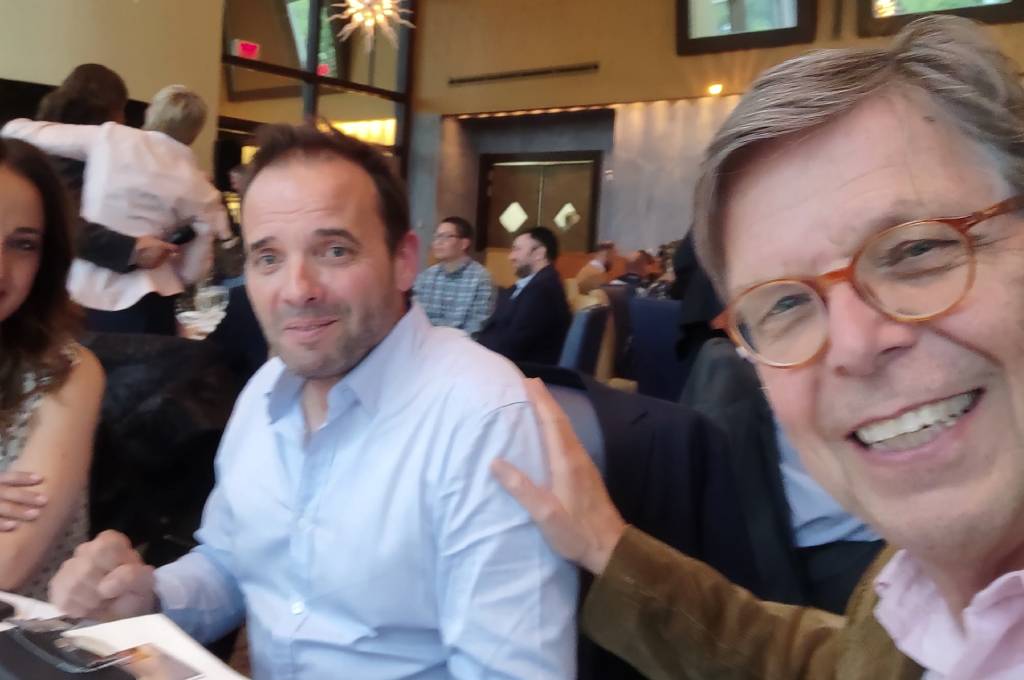
The Domaine Alphonse Mellot was founded in 1513. Alphonse Mellot sen. is the 18th generation of the vintner family in Sancerre. He took over the domaine La Moussière in1970 and was the driving force in the transformation of the family winery towards thefocus on top quality. With conversion to biodynamic viticulture he went much furtherthan other domains in the region at that time. The domaine is certified biodynamic since 1999. Today the 16th generation -Alphonse Mellot jun.- runs the domain. The winery sits in the middle of the town of Sancerre and occupies a maze of medieval cellars right under the town center, some date from the 15th century. The vineyard area is about 140 acres with a single plot of 75 acres of “La Moussière”, considered the best in Sancerre, solely owned by Mellot. “La Moussière” sits on a large block of Kimmeridgian soil whereas “La Demoiselle” sits on silex soils. There are also 33 acres of Pinot Noir and more vineyards (Chardonnay and Pinot Noir) on the IGP Côtes de la Charité. Domaine Alphonse Mellot is an iconic producer in Sancerre and that was recognized by the King of France, Louis XIV. long before our times. He named César Mellot as his personal wine advisor in 1698. |
EVENINGCheck-in at Le Panoramic Hotel in Sancerre.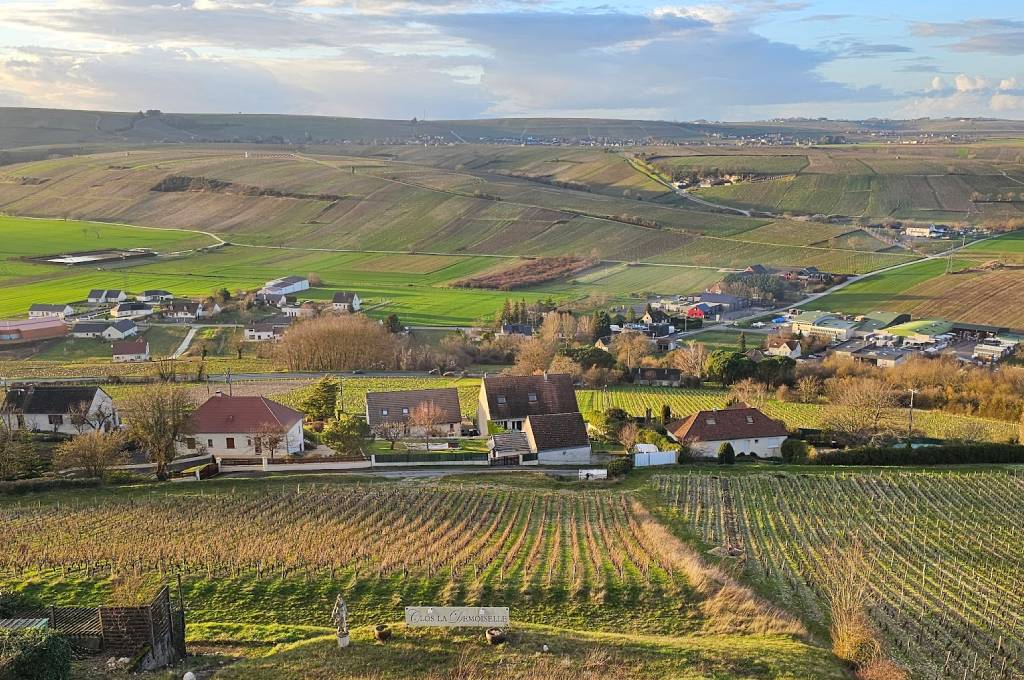
The best lookout-point over the vineyards of Sancerre and Chavignol is from your window in your room! |
Evening and dinner on your own.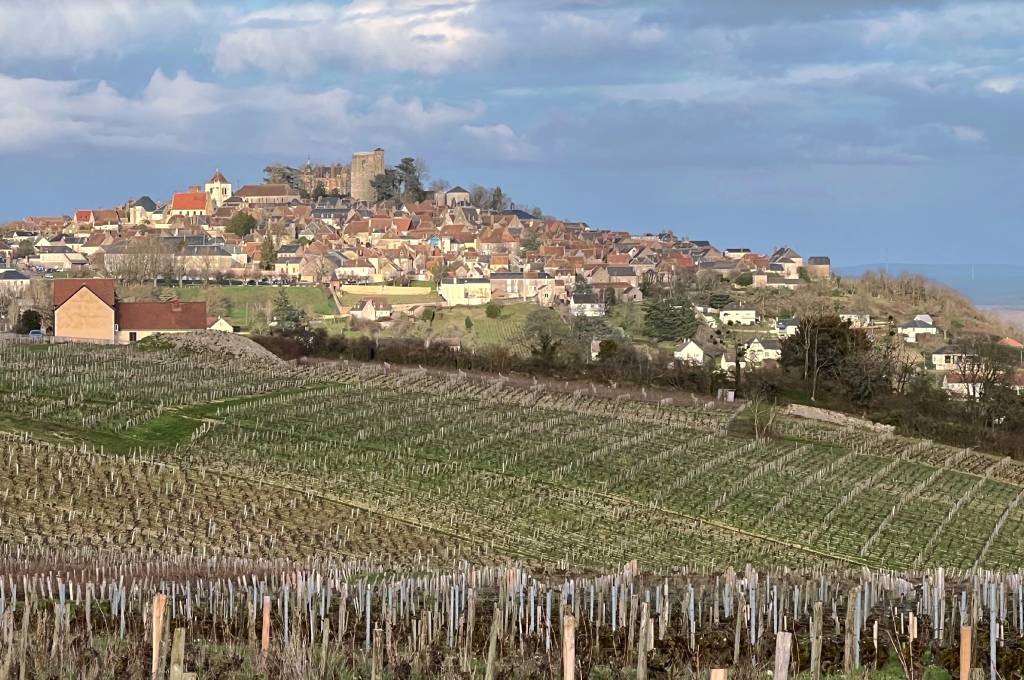
Enjoy a stroll through the medieval village. The village of Sancerre is perched on the top of a hill overlooking vineyards and fields. One can get lost in the maze of very narrow alleys crisscrossing the village. |
DAY 11: Wednesday, June 19 |
MORNINGVisit of Domaine de Vrillières in Sury-en-Vaux, Sancerre.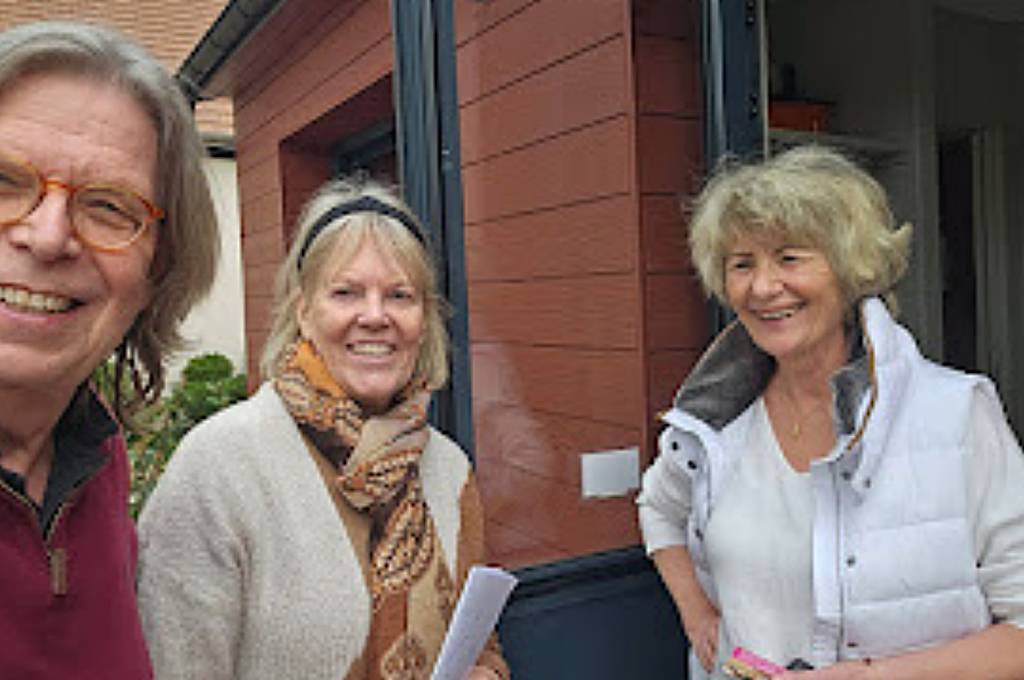
Owner of Domaine de Vrillères is the husband and wife team Christian and Karine Lauverjat. The Domaine lies in the village of Sury-en-Vaux in the heart of the Sancerre appellation. The property has been in the family for several generations, but Christian and Karine are the first to make and bottle their own wines. The 30 acres of vineyards are on the slopes of one hill, with two main soil types. The upper part of the hill is dominated by a limestone clay soil, known locally as terre blanche which produces full bodied, well-structured wines. The lower part of the slope has a pebble limestone soil known locally as caillottes which tends to produce lighter and more fruity wines. |
Visit od Domaine Tinel-Blondelet in Pouilly-sur-Loire.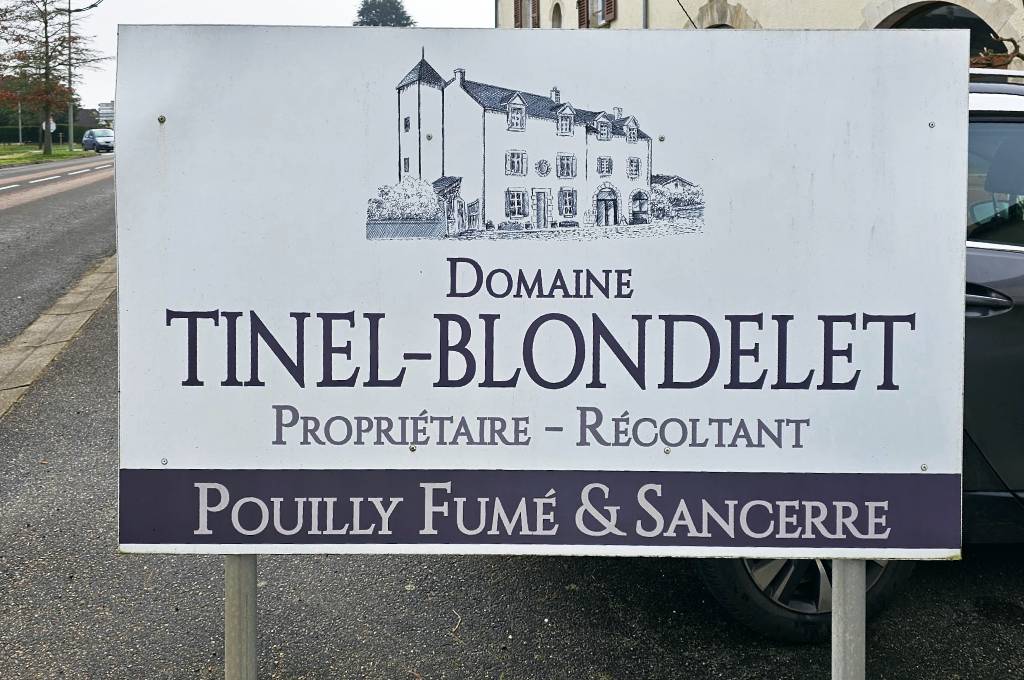
Domain Tinel-Blondelet can look back at 400 years as a family winery. Annick Tinel is the 12th generation managing the domaine. They farm a total of 37 acres in the Pouilly- Fumé, Sancerre, and Pouilly-sur-Loire appellations. Sauvignon Blanc is the main varietal here but Pinot Noir and Chasselas are also grown on the unique terroir, which has three different soil types: marl in Pouilly-Fumé, limestone and Silex in Sancerre. The vineyards are located near the Loire river which separates the Pouilly-Fumé and Sancerre appellations. All her vineyards have a perfect position: they are south-south west facing and the vines are on average 45 years old. |
LUNCHLunch at Restaurant / Affineur Romain Dubois in Chavignol.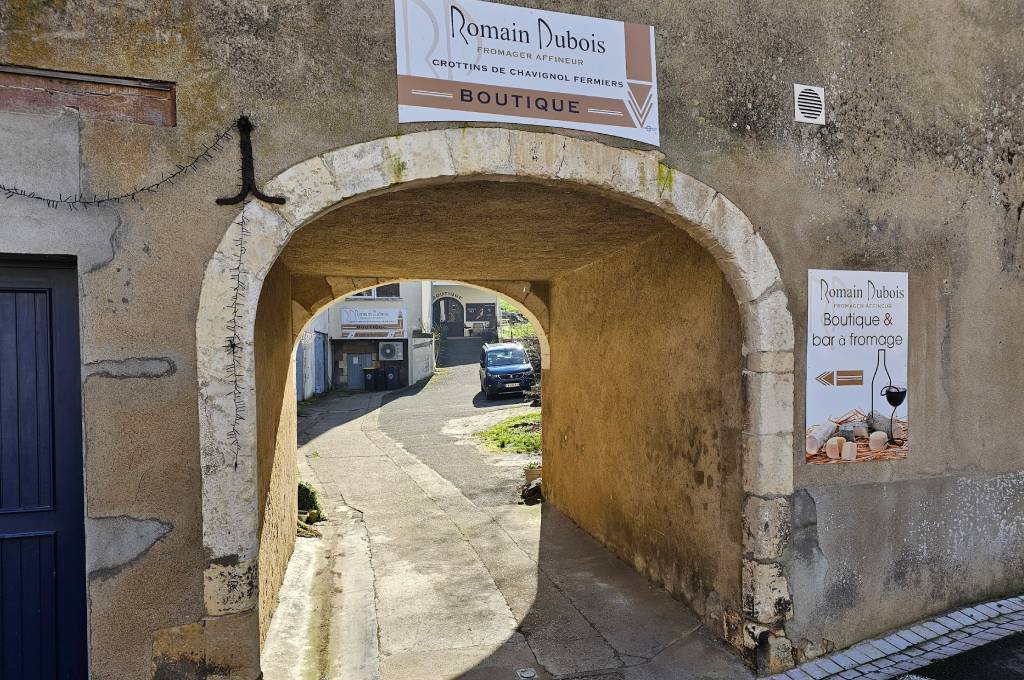
Romain Dubois makes this delicious Crottin Chavignol and other goat cheeses. We are here in goat cheese country and will have chesses of different degrees of ageing. We will also enjoy some great home cooked food true to the region. |
AFTERNOONVisit of Domaine Henri Bourgeois in Chavignol, Sancerre.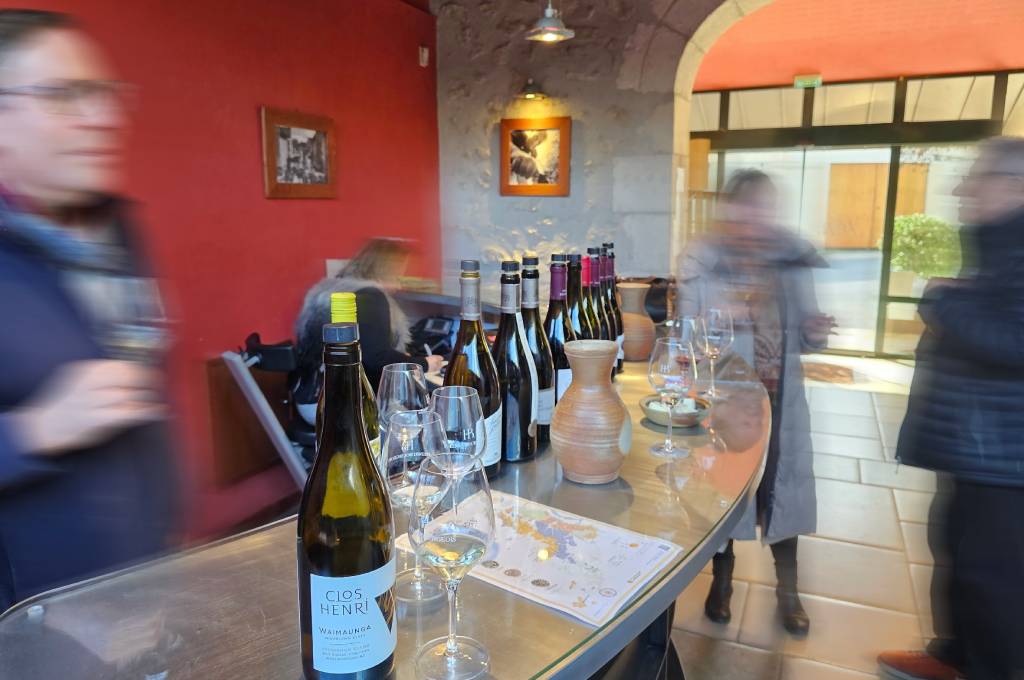
With determination and great commitment, the Domain Henri Bourgeois has placed itself at the top of the Sancerre region. The secret of the success are the gentle hills in the municipality of Chavignol. Here is the home of Sauvignon Blanc – you only find a few acres of Pinot Noir in this sea of Sauvignon Blanc. This family domain is one of the largest producers in the region with 176 acres of vineyards, mostly in the Sancerre appellation but they also farm some acres in the Pouilly-Fumé appellation. The domain sits right at the foot of one of the most prominent top vineyard site, the Côté des Monts Damnés in Chabignol. We had a great conversation and tasting with Jean-Marie Bourgeois and Jean-Christoph Bourgeois and I can only second what the German importer Hawesko says: “The wines are a wonderful expression of the unique characteristics of the Loire Valley. They combine freshness, fruitiness, and minerality to create a harmonious taste experience. Each wine tells its own story and bears the hallmark of the passion that goes into winemaking at Henri Bourgeois.” |
Tasting of wines from the Auvergne region.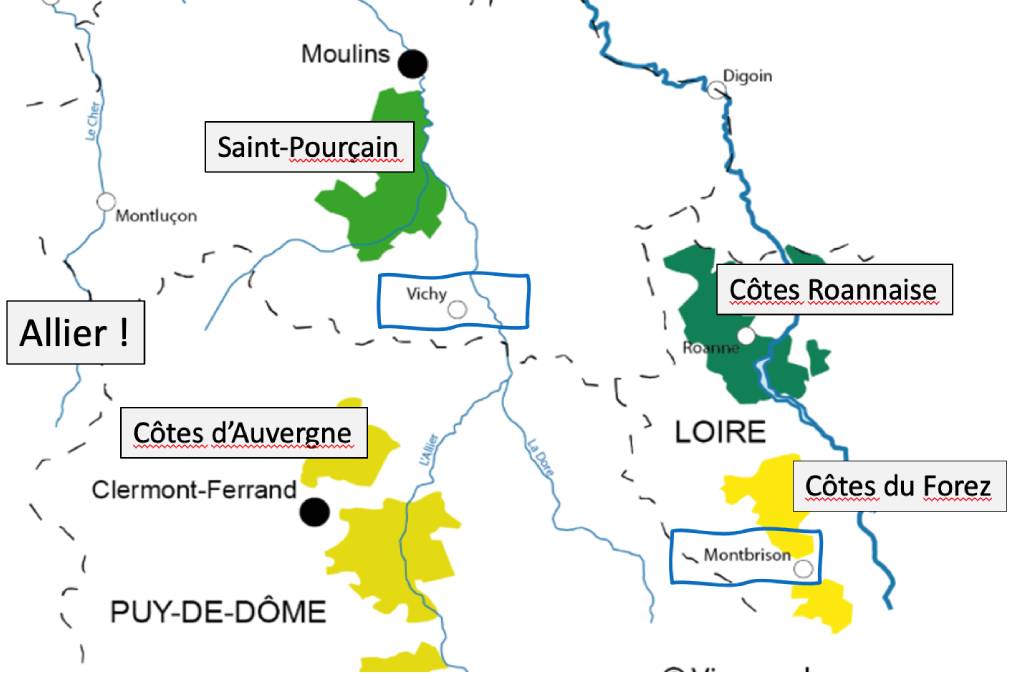
Before we head out to dinner we will have a tasting of wines from the Auvergne mountain wine region at the foothills of the Massif Central. This region is close to the Allier forest where the best trees grow for producing barriques and the town of Vichy, which manifested itself in the history books. This beautiful and remote region is about two hours south of Sancerre, parallel to Beaujolais and Northern Rhône close to the source of the Loire. |
EVENINGWINE PAIRING DINNER at restaurant Le Clos du Maréchal in Sancerre.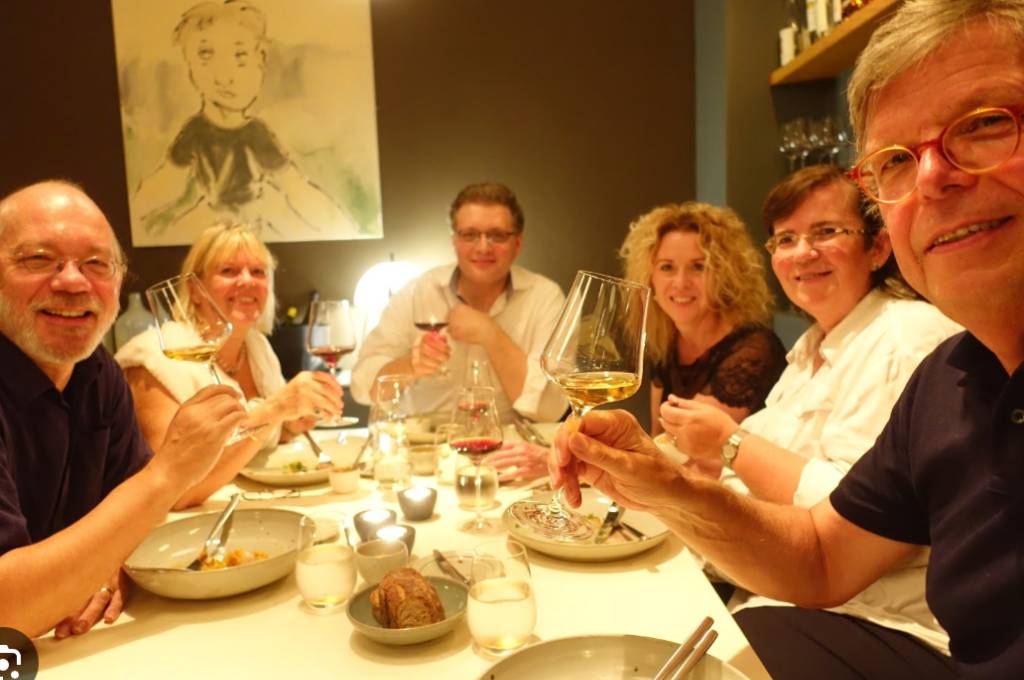
This restaurant is normally closed on Wednesdays but they open just for us for our last evening together. We will enjoy a fantastic meal in a historic, very cosy setting. |
DAY 12: Thursday, June 10 |
MORNINGBreakfast buffet at the hotel and drive to Paris |
LUNCHFarewell Lunch at La Coupole in Paris.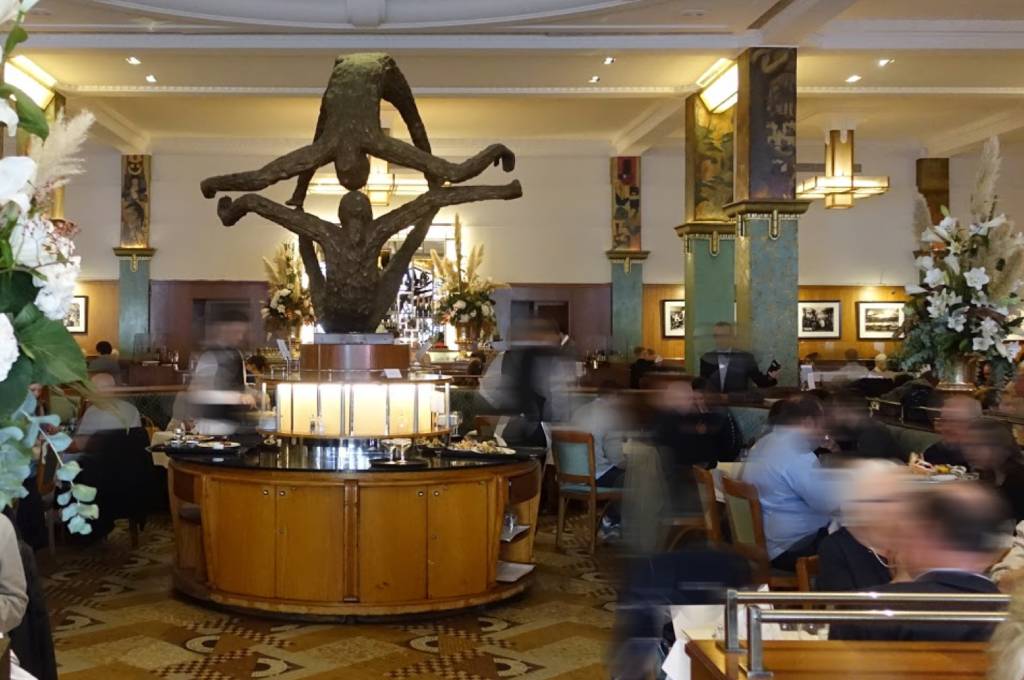
We will share a convivial meal with wines before we all head out to different directions. La Coupole is a historic Montparnasse café / restaurant (and an official French historic monument), which opened in 1927. This huge restaurant is a temple of Art Déco. It still symbolizes the “roaring twenties”. It was and still is to some lesser extent one of the hotspots of the intellectuals of Paris and abroad. Simone de Beauvoir, Jean Paul Sartre, Ernest Hemmingway, Picasso, Man Ray, Camus, James Joyce, Josephine Baker, Henri Miller, Serge Gainsbourg, Jane Birkin and countless others were regulars at La Coupole. Despite its large size the cuisine is very good and every dish is carefully prepared. |
| END of WINETOUR |

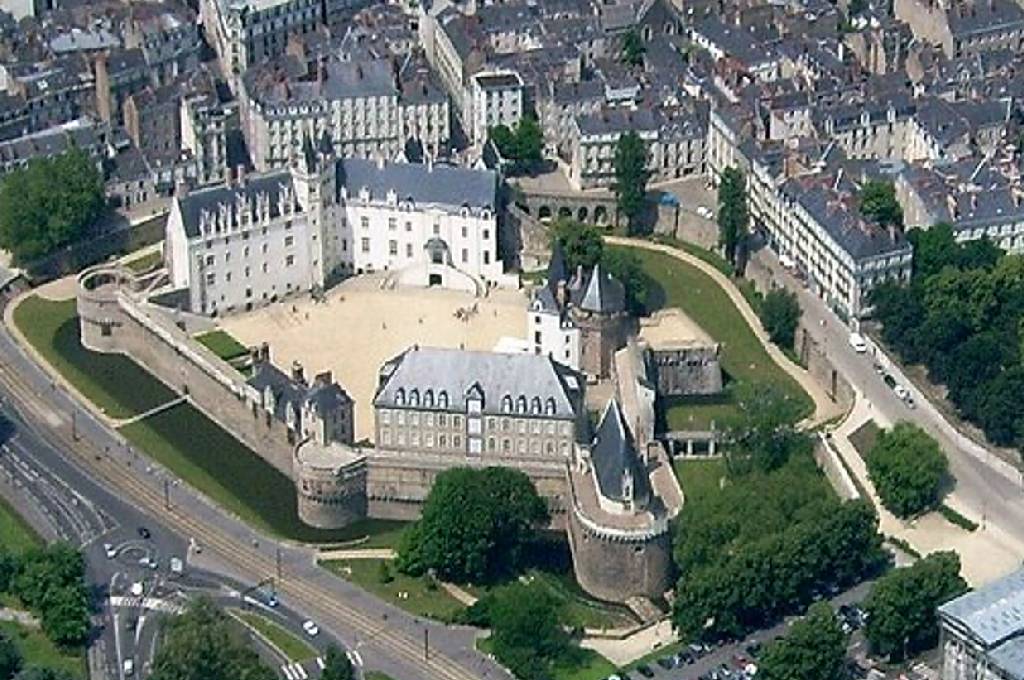 Today Nantes is France’s sixth largest city with a population of about 320.000 in Nantes proper and roughly 1 million in the metropolitan area. The ancient gallo-roman city of Namnetus, founded at a narrowing of the Loire and the confluence of the Erdre and Sèvre Nantaise, owes its rise to its extremely favorable geographical location. Located at the mouth of the river, Nantes was not vulnerable to attacks from the sea and was considered one of the safest seaports when overseas trade began. Nantes took on the status of an industrial and commercial metropolis. Nantes was conquered by the Bretons in 851 and was the capital of an independent Brittany for hundreds of years. In 1207 a fortress and château -the Château des Ducs de Bretagne-, was built which served as the residence of the kings of Brittany and the center of the historical province of Brittany. In 1446 the last Duke of an independent Brittany François II rebuilt the castle and this is the architecture as we see it today. After Brittany was annexed to France in 1532 -Anne of Brittany married the king of France- the Château des Ducs de Bretagne was used by the kings of France when they visited the region. After centuries of being the home to dukes and hosting kings and their courts, the castle, gradually abandoned, was put to use as both a barracks and a prison. In 1915, the City of Nantes acquired the building and had a museum added in 1924. In Nantes French history was written: in 1598 the “Edict of Nantes” was issued which legalized Protestantism to put an end to the religious wars and to unify France.
Today Nantes is France’s sixth largest city with a population of about 320.000 in Nantes proper and roughly 1 million in the metropolitan area. The ancient gallo-roman city of Namnetus, founded at a narrowing of the Loire and the confluence of the Erdre and Sèvre Nantaise, owes its rise to its extremely favorable geographical location. Located at the mouth of the river, Nantes was not vulnerable to attacks from the sea and was considered one of the safest seaports when overseas trade began. Nantes took on the status of an industrial and commercial metropolis. Nantes was conquered by the Bretons in 851 and was the capital of an independent Brittany for hundreds of years. In 1207 a fortress and château -the Château des Ducs de Bretagne-, was built which served as the residence of the kings of Brittany and the center of the historical province of Brittany. In 1446 the last Duke of an independent Brittany François II rebuilt the castle and this is the architecture as we see it today. After Brittany was annexed to France in 1532 -Anne of Brittany married the king of France- the Château des Ducs de Bretagne was used by the kings of France when they visited the region. After centuries of being the home to dukes and hosting kings and their courts, the castle, gradually abandoned, was put to use as both a barracks and a prison. In 1915, the City of Nantes acquired the building and had a museum added in 1924. In Nantes French history was written: in 1598 the “Edict of Nantes” was issued which legalized Protestantism to put an end to the religious wars and to unify France.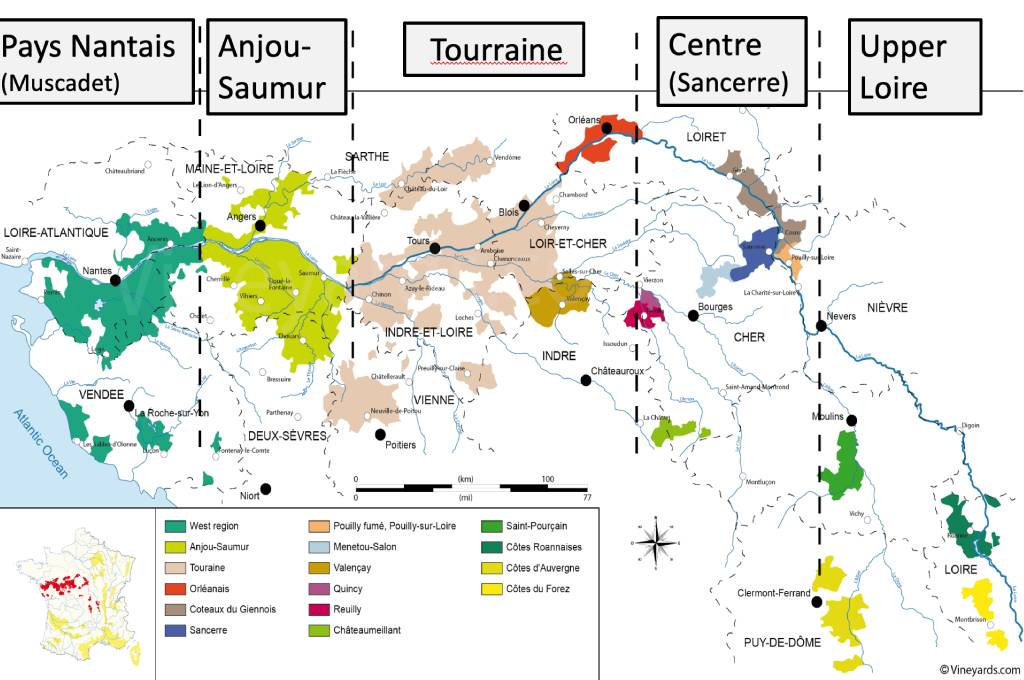
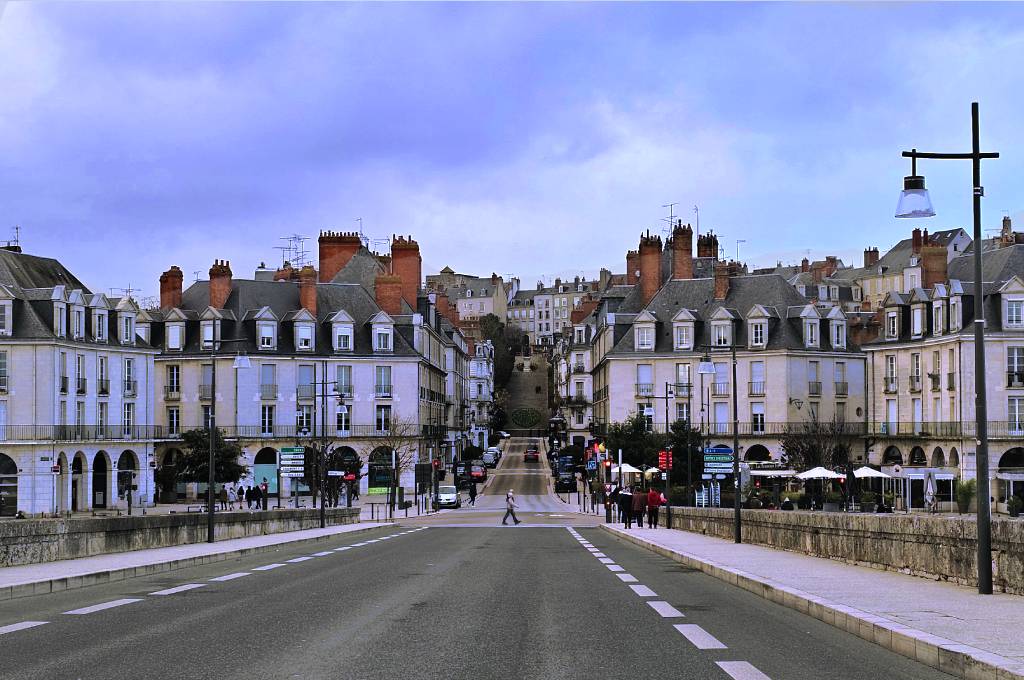
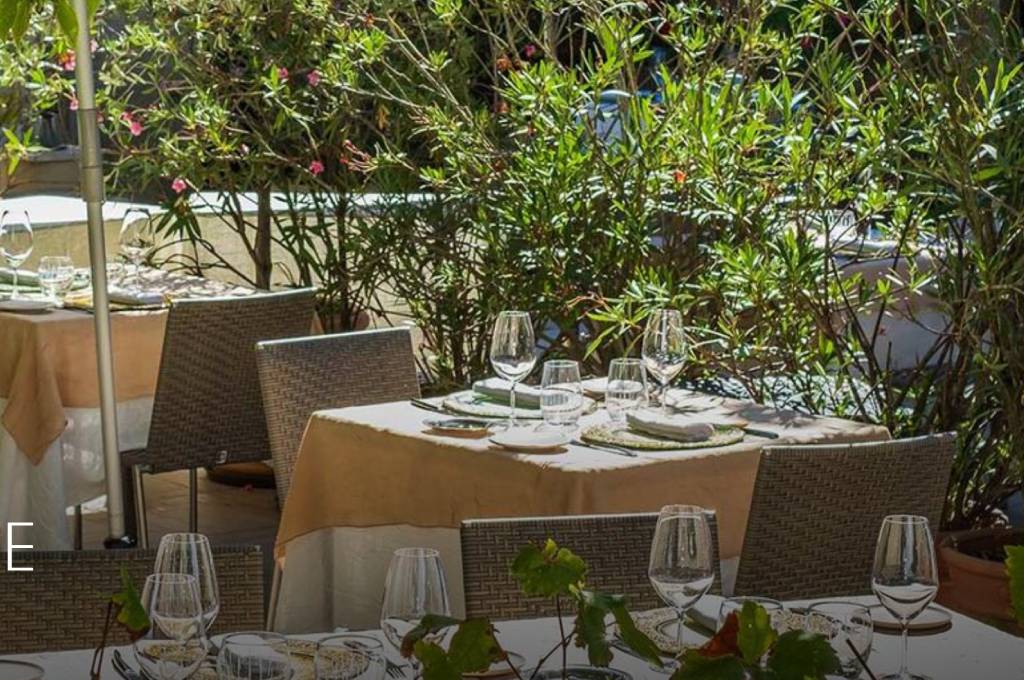 This snack bar is located in the garden of Château Chenonceau.
This snack bar is located in the garden of Château Chenonceau.






